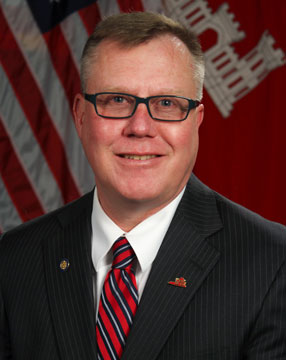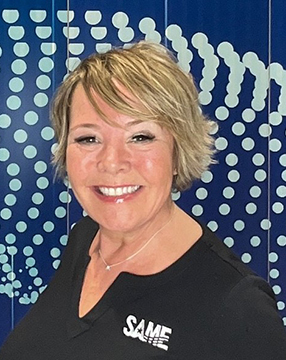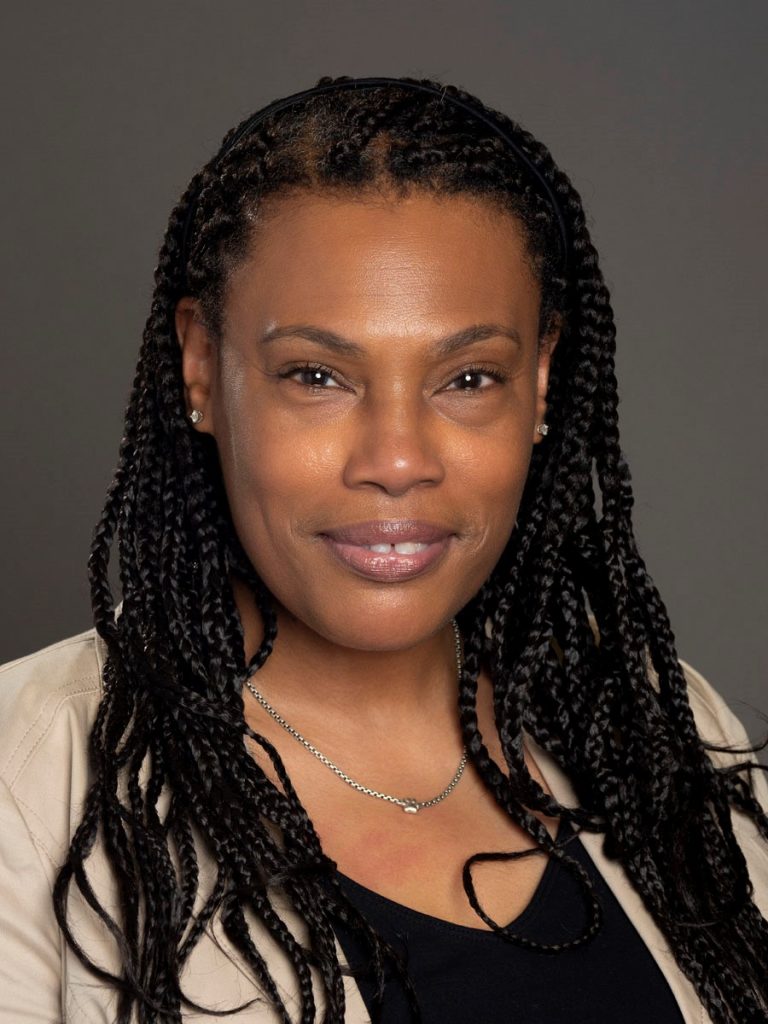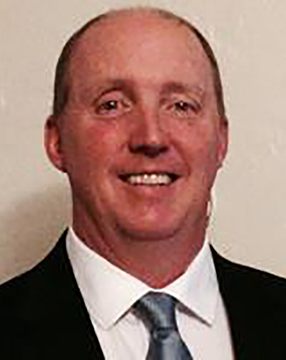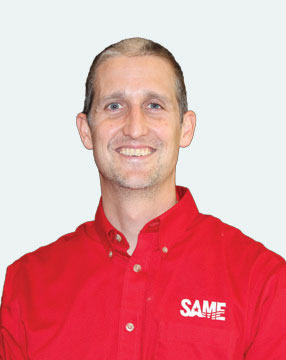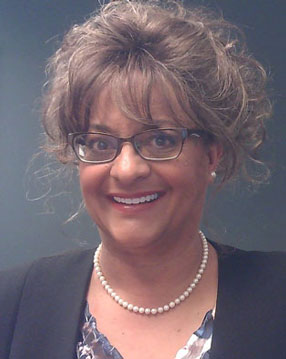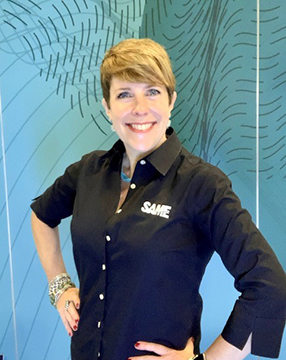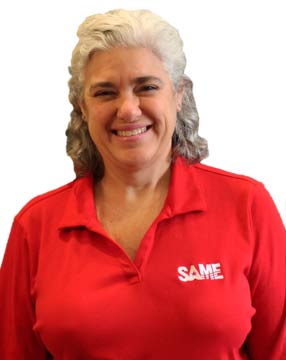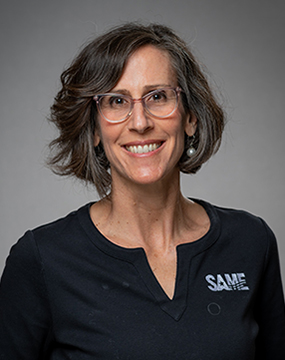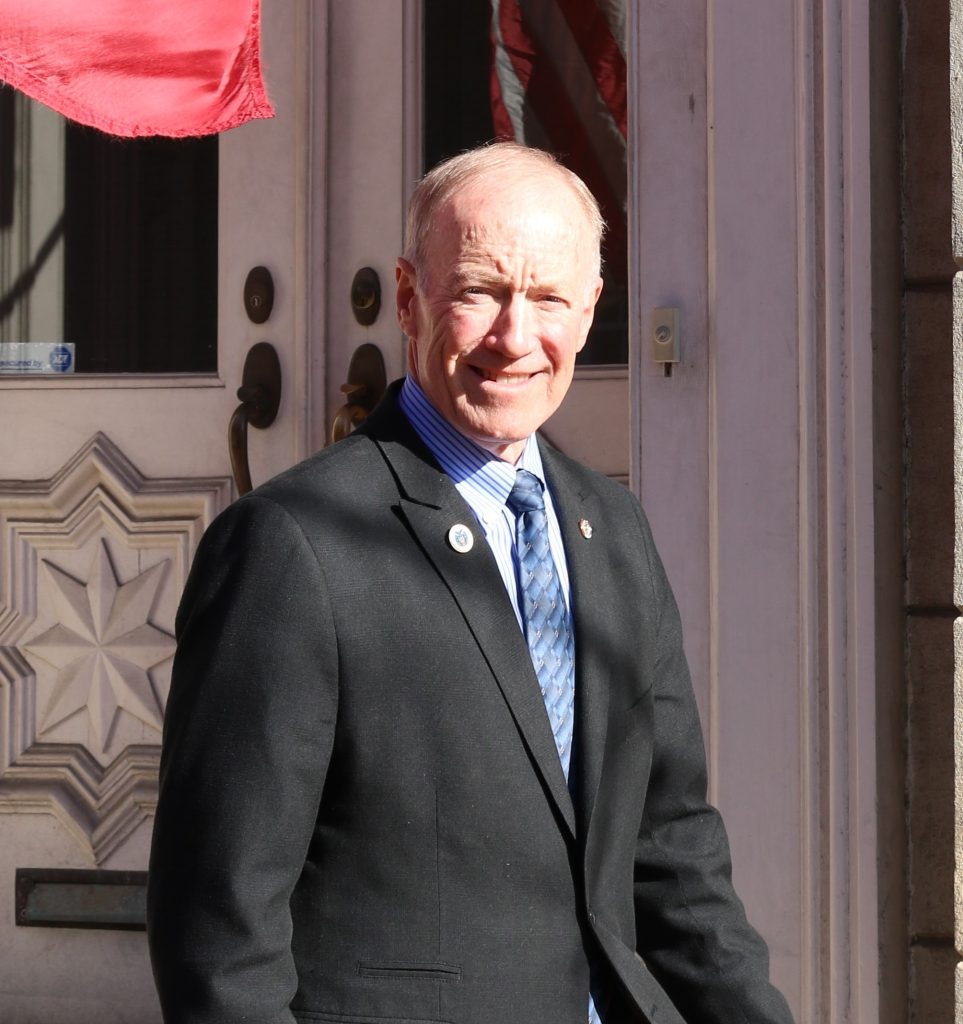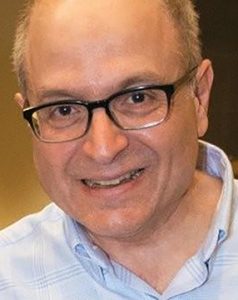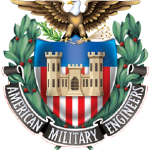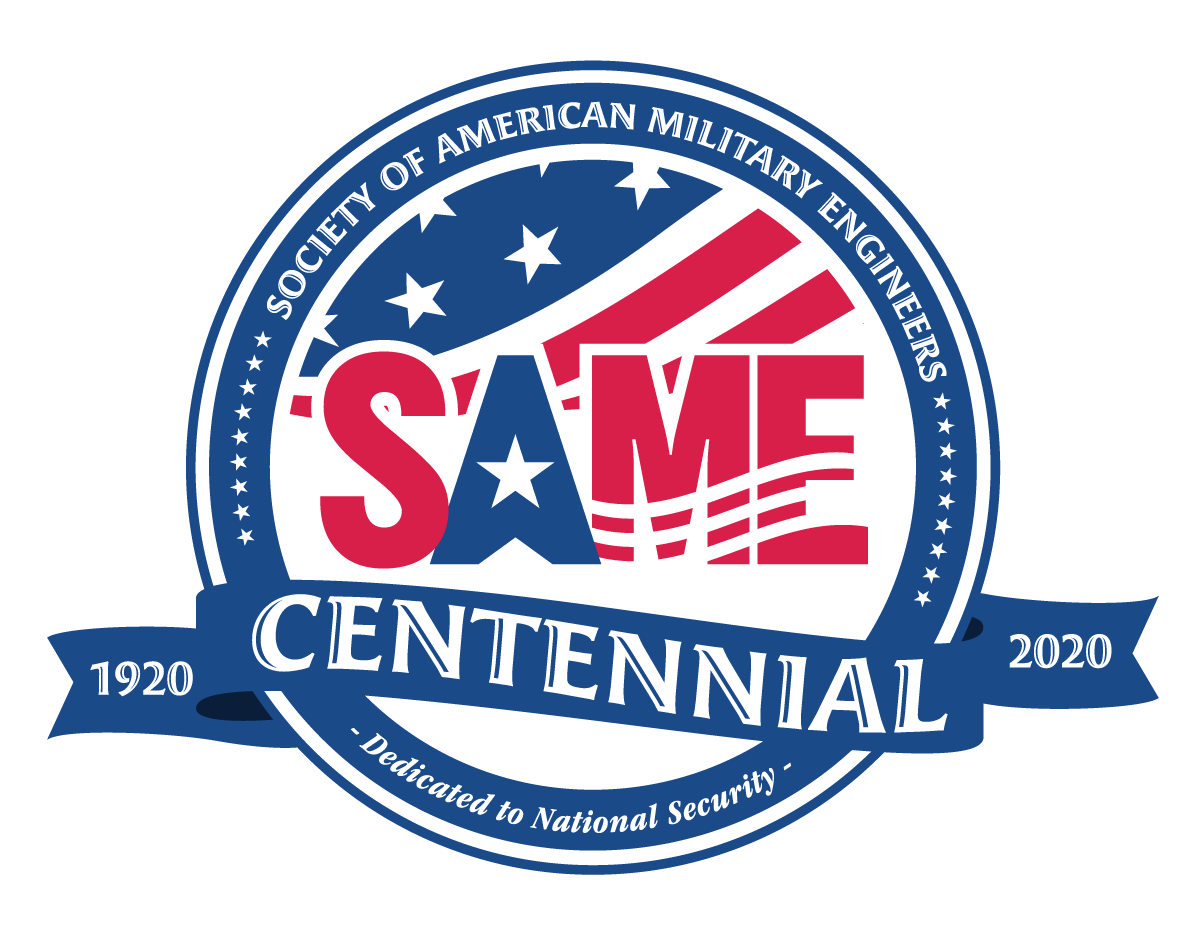
The Once-in-a-Lifetime Event That Nearly Wasn’t
An Oral History of the 2020 JETC, COVID-19, and Sprint to the Start of SAME’s Second Century (Virtually)
What was supposed to serve as SAME’s Centennial Celebration, instead, because of the coronavirus pandemic in spring 2020, led to the first-ever Virtual JETC and a host of unexpected changes within the organization. While this all pales to the life-saving work of thousands in the medical fields and their heroic actions, for SAME it was a turning point still to remember.
This period of about 45 days, and then over the next year and a half, would set the Society on a momentum-filled path into its second century—and on a path to where we are today as a professional engineering association focused on industry-government engagement and developing people, driving partnerships, and delivering solutions through our mission of leading collaboration.
Telling the story of the 2020 JETC is really telling the story of how SAME, its members, and staff adapted and then thrived in the face of an historic obstacle.
3/12/2020
In support of our national security, and as underscored by President Trump’s message to the nation and emergency declarations being made in communities throughout the country, SAME is joining the effort to contain the spread of COVID-19.
We feel it is prudent to be very deliberate in deciding whether to proceed with in-person gatherings for now.
In that spirit, we have made the decision to cancel the 2020 SAME Capital Week (scheduled for March 16-18 in Rockville, Md.). However, we are currently working on a way to try to be able to record the briefings and capture the value of the event for our members in a virtual way—as we know the information provided by speakers from the government is crucial to the near-term and long-term strategic planning of the A/E/C industry firms that support our nation and our military’s critical facilities, infrastructure, and resilience needs. To that end, we encourage Posts, Communities of Interest, and other groups within SAME to use this situation of coronavirus as an opportunity to be creative (leverage technology) and flexible for the benefit of our members.
The work that SAME members, partners, and stakeholders do is vital to national security, and building relationships and trust through their interactions in the Society is a critical part of how they do it. However, right now the focus needs be on containing the spread of coronavirus in an effort to shorten its duration. Reducing community spread and limiting in-person gatherings are necessary approaches to take.
We are sure you are wondering what this means for the 2020 JETC in Washington, D.C., May 27-29. Given that the event is not scheduled until the end of May, over two months from now, planning currently is proceeding as scheduled. We will continue to follow local and national guidance; therefore, a change in decision on the event’s status, should it become necessary, will be made at a later date.
SAME is dedicated to the health and safety of all its members and event participants, and we thank you for your understanding during these unprecedented circumstances in order to help contain the spread of the coronavirus.
SAME National Office, Memorandum to the Membership
3/31/2020
We are sorry that we are unable to hold our 2020 JETC, originally scheduled for May 27-29 in Washington, D.C., as planned. The Society’s National Leadership Team and SAME National Office are exploring alternative options for how to provide the value offered at JETC (such as education and training) and hold many of the key elements of JETC (such as the Society Awards and LDP graduation) in conjunction with another event or as a stand-alone event. While right now the focus must be on containing the spread of coronavirus, we look forward to being able to come back together when the time is right, celebrate our Centennial with those who have built SAME’s legacy of service, and kick off our second century of impact to our nation, and our profession.
SAME National Office, Message to JETC Registrants
Thank you for your support and understanding. We will provide additional information on alternate opportunities as it is available.
4/1/2020
Dear friends and fellow members/leaders,
This video on the history and origin story of SAME has always stuck in my mind since I first saw it, I believe in 2012 or a few years earlier. Not sure how many SAME members have actually taken the moment to view it. I very rarely hear people speak of it. It means more today than ever as we struggle as a nation to find the right way to make public-private partnership work, and to harness the best aspects of public good and private capabilities.
I am more proud than ever to be a Life Member and Fellow of SAME, and will encourage people to share with others who may benefit from the reminder of why our powerful organization exists to bring the best resources together in times of great need. It all comes down to people: SAME Strong!
Wendi Goldsmith, Ph.D., CPG, F.SAME, Center for Urban Watershed Resilience, and TME Contributing Editor
5/6/2020
Announcing Virtual JETC! Adapting for Today, and Tomorrow
We have retooled to provide you with the education, training, and networking opportunities you need to stay up to speed with all that is happening in the federal A/E/C sector—because supporting national security never stops!
That’s why we are pleased to announce Virtual JETC: Adapting for Today, and Tomorrow, beginning May 27, when JETC was originally scheduled to start! The program we have planned allows you to fully participate during the conference hours or as it best fits your schedule. Sessions can be experienced live in a virtual environment or by access later to a recording on demand. Plus, PDH credits will be available for all education and training sessions—regardless if you listen live or later!
SAME National Office, Message to SAME Membership Registrants
Through Virtual JETC, and thanks to the continued support of our sponsors, you will hear from government decision-makers and industry leaders and get a detailed look at how our profession is pivoting to tackle the infrastructure-related national security challenges we are all facing in this unprecedented environment. Join your colleagues for this extraordinary opportunity to come together to learn, share, and connect, virtually.
5/14/2020
Good Afternoon Centennial Commission,
I wanted to personally CONGRATULATE Belle Febbraro and the National Office for successfully hosting the first Pre-Conference Session for SAME’s Virtual JETC 2020!
Today’s Pre-Conference Session topic was entitled “Virtual Interview Skills/ Tips & Tricks.” The session provided ideas for remote employees to present themselves confidently and clearly communicate their skills, aptitude, and attitude in video and phone interviews. As you can imagine, many attendees quickly shared that the tips provided were relevant and could easily be adopted by each of us as we are now engaging with our clients and peers remotely. I enjoyed seeing the real-time results of “polls” conducted and the level of active attendee participation with Q&As throughout the session! Great start to our Centennial JETC! I am confident this is just the beginning of a memorable Virtual JETC 2020. Hope everyone is staying safe and remaining positive!
Cindy Lincicome, F.SAME, TLI Construction, SAME Centennial Commission Chair (2018-2021)
5/22/2020
To All Our Moderators and Speakers,
On behalf of the SAME National Leadership Team and our National Office Team, we want to thank you in advance for your generous and unhesitating commitment to “pivot” with us from what was going to be the Centennial JETC of the ages, to our inaugural Virtual JETC which will kick off a very different, but no less vibrant, Centennial Year! What a way to start our second century of service to our nation and to our profession. And YOU made it happen for us! THANKS!
We truly cannot thank you enough. Deeds Not Words!
Brig. Gen. Joseph Schroedel, P.E., F.SAME, USA (Ret.), SAME Executive Director (2014-2023)
5/28/2020
I am sitting here listening to Heather’s comments (Day Two of Virtual JETC) and really wishing the entire country could hear them because that is exactly what we need to hear. We have been here before; we have lived through worse; we have endured unimaginable things. And it feels so fresh, and so new and so frightening to so many—but that kind of optimism, and that kind of sincerity, and that kind of certainty from a 100-year old organization, that’s what our country needs to hear.
Mike Rowe, 2020 Virtual JETC Keynote Speaker
6/17/2020
Team, We’ll hold our internal staff VJETC AAR today, but I wanted to make sure everyone got the survey results from VJETC. Lots of good information in here, so take a look at the results. Again, VJETC was a great staff team effort and we had the fortune of tremendous commitment from our volunteers, without whom we would not have had a VJETC. So, in every way, this was a total Society success!! Thanks again for everyone’s effort.
Brig. Gen. Joseph Schroedel, P.E., F.SAME, USA (Ret.), SAME Executive Director (2014-2023), Email to National Office Staff
A Global Threat Tests National Resilience
In the winter of 2019, faint murmurings of a virus spreading into cities around the world began to grow louder. Doctors were baffled by the mysterious respiratory illness that sent dozens to the hospital, and infectious disease professionals struggled to locate its origin. At first, much of the world paid little attention. Another regional outbreak, maybe a seasonal flu—it was nothing out of the ordinary to worry about. To many in the United States, it was inconsequential. But this virus was persistent, spreading through airports, train stations, concerts—anywhere people gathered. It moved slowly before symptoms showed, then lighting fast. Unsuspecting travelers carried the virus without knowing they were infected, sending it to destinations around the world.
It was already too late. The coronavirus had taken advantage of our interconnected, globalized world and swiftly grew into a pandemic that would ultimately leave more than five million lives lost, devastate economies, inflict overwhelming damage on education and mental health, forever upend traditional structures and systems, and leave a permanent mark on history.
COVID-19 intimately affected the Society of American Military Engineers—and not just because of both the immediate and protracted demands put on the entire engineering and scientific community, with SAME members operating in their professional roles at the highest levels of the response from government and industry.
The pandemic would also disrupt the long-awaited 100th anniversary of the Society and, in the process, reshape many fundamental understandings of the organization. Founded in 1920, SAME was expecting for 2020 to serve as the capstone to a multi-year strategic build-up that would launch it into its next 100 years. Numerous local celebrations were scheduled throughout the year. An anniversary book was commissioned. A national celebration was slated for May in Washington, D.C., years in the making. Unknown at the time, none of it would happen as planned.
Lt. Col. Wendell “Buddy” Barnes, P.E., F.SAME (Dist.), USA (Ret.), 100th National President, SAME (2019-2020): The only thing that I can liken the immediate effect of the pandemic to was in 2001 when the towers came down. I was in Philadelphia for a conference during 9/11, walking into the convention center, and I see this activity on the TV screen. None of us could believe it was real. But then we canceled everything, and they said: “Everyone, get back, go home.” How do you go home when that’s happening? I drove my rental car back to Houston, and that was the most eerie thing I’d ever seen. There wasn’t anything in the sky.
For the Society of American Military Engineers, the lingering lessons of the uncertain time surrounding the beginning of the COVID-19 shutdown are permanently etched in the organization’s culture. Members found their readiness tested as they wholly threw support behind health engineering projects, viral research, healthcare deployments, constructing alternate care facilities, and other emergency projects to slow the spread of the virus. Others were challenged to deliver ongoing projects, many mission-critical, in a new world of social distancing and virtual communication, most exacerbated by strained supply chains and material scarcity.
The onset of the pandemic coincided with the Society’s planned Centennial Celebration, an event to mark the 100th anniversary of SAME’s founding. Facing bans on public gatherings, plans needed to shift quickly. JETC 2020—slated for May in the nation’s capital and envisioned as the culmination of a three-year Centennial Campaign—could not go forward as planned. The similarities to the environment of SAME’s establishment in 1920, and the devastation of the Spanish Flu outbreak, were unmistakable. Like then, SAME, and the engineering community, forged onward.
Drawing on the uncompromising support of dedicated members and a truly cohesive staff, the Society stepped ahead into the unknown, committing to holding the conference as a virtual event. Those few short weeks leading up to Virtual JETC would prove to be some of the most transformative days of the organization, as it not only retooled its systems for a new virtual-only environment, but recommitted itself to its founding principles: finding ways to bring industry and government together to address national security and enhance readiness, even during a pandemic-induced lockdown.
Brig. Gen. Joseph Schroedel, P.E., F.SAME, USA (Ret.), 17th Executive Director, SAME (2014-2023): JETC was the pivot point. That’s where we proved we could adapt and not just survive, but thrive. And I always said that we are not just going to survive this thing, we’re going to thrive.
Buddy: We were going to celebrate in Washington, D.C., with World War I equipment and re-enactors. It was going to be quite a show. We were going to use three years to carry it all out, the year I was there, the year Heather [Wishart-Smith] was going to come in as President, and then whoever was going to follow her, which would be Mark [Handley].
Part I: Once in a Century Opportunity
In 2014, Brig. Gen. Joe Schroedel, P.E., F.SAME, USA (Ret.) took the helm as SAME’s 17th Executive Director. At the time, the Society was facing a culture shift as it only recently had moved to a fully volunteer national leadership model due to federal regulatory changes. Keeping the tightly knit interaction with the engineering services, without the chiefs at the helm as SAME President, would require a paradigm shift in the Society’s culture. That SAME was nearing its Centennial proved a serendipitous opportunity to accelerate that evolution.
Stephen Karl, Communications & Marketing Director, SAME (2011-Present): By 2020, we had just concluded a stretch where the Society had evolved a lot in a short amount of time. We had a new governance model as of 2012. Then Joe walked in the door in August of 2014, a couple years into this new governance structure. Things began to move; the centennial was the motivator to get us going.
I started working for SAME in 2016, and at that point, Joe was already starting to talk about our upcoming Centennial.
Jill murphy
Buddy: We were still in our very early years as a fully volunteer-run organization at the national level. I was part of that transition period, but it really started to move forward in the years leading up to and when I served as president. That’s where we really started getting the Board of Direction more active and working with the staff. You could see that the volunteer leadership truly was not just showing up for a speech but was involved in running the organization. The Society depended on the continuity of the volunteer leaders.
Joe: I said that SAME’s role is going to be to provide value. We wanted people to freely participate because we had gained the confidence of the government agencies and the military. There was a lot to it, but it came down to bringing people together to discuss real issues related to engineering and national security and offer real solutions through collaboration. I called it industry-government engagement. Focus on building trust and trusting relationships. That was the heart and soul of IGE. The IGE culture that started in 2015 caught on, and the term caught on, because industry-government engagement is not about contracts or access, it is about relationships and trust and collaboration.
Stephen: Up until the governance change, the service engineering chiefs had been SAME President on a rotating basis for the better part of nearly 60 years. We were coming off sequestration around 2013. A lot of headwinds over a two- to -three-year period. In retrospect, you can see how it was actually a unique new opportunity to evolve the organization. Joe saw that from the beginning.
Within two years of joining SAME, leadership was already looking ahead and making preparations to celebrate the Society’s Centennial, which would occur in 2020.
Caroline Roberts, GISP, F.SAME, SAME Northwest Regional Vice President / Co-Chair, LDP Task Force (2016-2020): Mike Darrow and I had a call every Friday for several years to develop a curriculum, write guidance, and develop a platform for this new Leader Development Program that would graduate at the 2020 JETC. We had been marching toward this milestone for five plus years. This cohort of 20 people from all over the world—private sector and military—were going to walk across the stage at graduation.
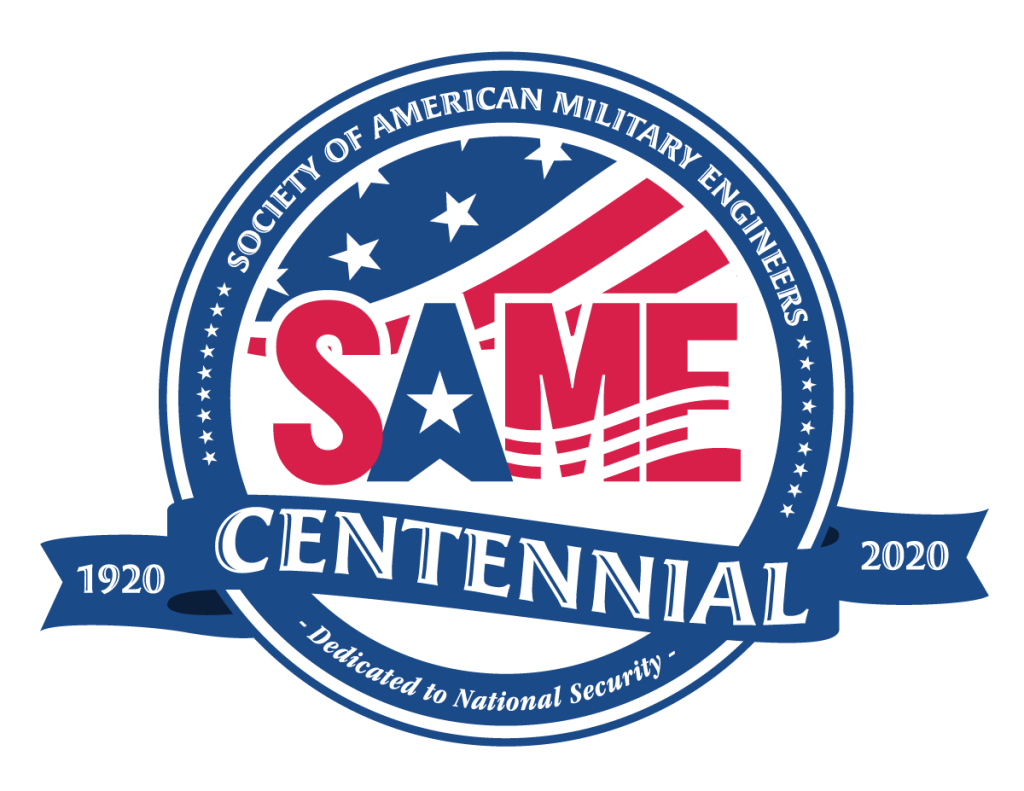
Lt. Col. Mike Darrow, P.E., PMP, F.SAME, USA (Ret.), former SAME National Vice President / Co-Chair, LDP Task Force (2016-2020): I was an Appointed Director at the time working alongside Caroline Roberts with our first Leader Development Class. The first class was to graduate with huge fanfare at the Centennial JETC in Washington D.C.
Jill Murphy, Membership & Post Operations Associate Director, SAME (2016-present): I started working for SAME in 2016, and at that point, Joe was already starting to talk about our upcoming Centennial. He was very forward thinking in that manner. We called the lead-up campaign “The Run to 2020.” We had polo shirts made, red polo shirts with the Centennial Logo on them that our designer Jada Matthews created. All the board members got them for three years. We gave them to everybody who attended Post Leaders Workshop for at least two years, maybe even three.
Stephen: Our 100-year anniversary was in 2020. So we had to put a marker down that over the next five years, we were going to focus on getting to our Centennial. We were going to make an impact and really raise the stature of SAME and use this once-in-a-lifetime opportunity to bring attention to the organization. That was the vision.
Buddy: The build-up was driven a lot of our executive director at that time, Joe; he was the brainchild of what we were going to do to leverage the Centennial, and then, and we all bought in on it, the whole board we were in.
Joe: I told Stephen, I said, “ask Jada to come up with five different unique designs for the Centennial logo.” I think she actually came back with six. And I said, when she comes back with the designs, if we have a hard time picking one, then she achieved her job. You know, we were like, dead even on all six. The only thing that made the difference was the one we picked was circular, and it was the only one that was circular. I had just made some offhand comment, “you know, with a circle, there’s no end!” The minute I said something like that, the lights went on. They were all good though, and very unique.
The 100-year celebration was envisioned as more than “just a party.” It was to be a year-long event that would both honor SAME’s storied past while simultaneously providing a platform to launch the Society into the next 100 years.
Stephen: It was a serendipitous opportunity. We had a new Executive Director and we had a new governance model. You had a lot of energy around those two changes, but then you also had this Centennial Celebration that you’re never going to get again. So, we said, let’s do something with it.
Joe: This was an effort that started in 2015. We were intent on changing the culture of the organization for the long term, and we were using this Centennial essentially as an opportunity to create that culture shift.
To manage everything that the Run to 2020 would encompass, a special national-level Centennial Commission was formed, and Cindy Lincicome was appointed as its commissioner.
Cindy Lincicome, Centennial Commissioner (2018-2021) / 103rd National President, SAME (2022-2023): I was asked to serve as the Centennial Commissioner in 2018 for the next three years. That allowed me the opportunity to continue to serve at the national leadership level and be a participant in how we set the course and build the momentum for the Society leading into 2020 and beyond. We were always on a mission to find ways to continue to bring value to the members.
Joe: Cindy Lincicome had been a National Vice President, and she had been on the national leadership team for a couple of years, and it was time for her to leave the team as her term was ending. We created this position called the Centennial Commissioner, and the new leadership team made Cindy the Commissioner to keep her on the leadership team for continuity because she was the right person to pull this off.
Stephen: Cindy’s role was, in part, to ensure that we had resources to spend on all the activities that we wanted to do at the Post level and also nationally. It was to ensure that our Posts would hold a celebration to complement the national celebration. And these were all happening, really in earnest, in 2018. Most importantly, Cindy became the “go-to” of the planning phase for the membership and the staff; it gave us one leader we could reach out to for guidance and direction.
As part of the 100th anniversary commemoration, a comprehensive account of SAME’s history was planned to be published as the “Century Book,” officially titled, The Second Century Begins: Preparing for the Future by Building on the Past.
Cindy: As the Centennial Commissioner, I had the privilege of working with Stephen Karl as he and his team put together our SAME Century Book, which is just a phenomenal tool that I think any member, whether you are new or a seasoned member, should really take a look at, because it so well defines and captures our history.
Mike Winkleman, Founder, Leverage Media LLC: In late 2018/early 2019 we were hired to work with the staff to write, design, and produce the Century Book. So we assembled a team and descended on Alexandria (home of the SAME National Office) to meet with Stephen and Joe, where we spent two days talking about what this book ought to be and how we ought to do it. We really wanted to show the unification of the Posts and national quality of the organization.
As the calendar turned to 2019, the Centennial was in sight, and the Society was sprinting—in a fairly literal sense—toward it.

Buddy: I was the National President for the year before our Centennial, and the theme for my presidential year was “Sprint to the Start of the Second Century.” I chose that because we had been building up to the second century for the last few years, but now we’re in the last year, so we’ve got to run.
Stephen: Buddy Barnes really built his presidency around this sprint to the start of our second century. So if the Run to 2020 had been what we had been doing for a few years, we were in the sprint now, the final sprint to 2020. Buddy even wore red running shoes everywhere he went because he was sprinting.
Buddy: Yes, I chose to wear red tennis shoes at every event. There was even one event where I was in a tuxedo, and I didn’t think it was appropriate to wear red shoes. Then the Army Chief of Engineers called me out and said, “Buddy, where are your red shoes?” And from that point on, if you see me in a tuxedo, I’ll still be wearing red shoes!
Belle Febbraro, Associate Director, Education, SAME (2010-present): There was a huge vibe going on about JETC and the Centennial, especially because Buddy Barnes was all about The Run to 2020 with his red shoes. It was this huge vibe. All the Posts were so psyched and excited about it.
A steady drumbeat of planning and preparing for the 2020 Centennial involved everyone from National Office staff to Society officers to Post members around the world, who were making preparations for their own Centennial celebrations to complement the events planned on the national stage.
Buddy: The build-up year was going really, really well. All the Posts around the nation were planning to do something as part of the Centennial. Everyone had their own particular way they wanted to celebrate, whether it was a young Post, or one of our original charter Posts. Every Post was going to pick an event that they were going to call their Centennial Celebration. We encouraged them to do something that was meaningful locally—because at our core, that’s what SAME is: a Society of local Posts. I was able to attend several before COVID hit.
There was even one event where I was in a tuxedo, and I didn’t think it was appropriate to wear red shoes. Then the Army Chief of Engineers called me out and said, “Buddy, where are your red shoes?” And from that point on, if you see me in a tuxedo, I’ll still be wearing red shoes!
Buddy Barnes
Col. Rich Houghton, F.SAME, USAF (Ret.), former SAME Southwest Regional Vice President: As an Elected Director at the Great Basin Post, we were really trying to gather momentum and excitement here in Team Utah so we could go out to Washington, D.C., in force and represent the Mountain West as a puzzle piece of that huge puzzle that was 100 years of SAME celebration and partnership and success. We were going dig up our charter and have history quizzes and reconnect with some of the successes and milestones and lessons of the past. We were talking about, how do we bring the past alive? What could we do? And all that was rolling up to having a big crew out in DC in May for JETC 2020.
Jill: My role was really, really focused on the Posts and getting them to embrace the idea of celebrating the Centennial, encouraging them to have Centennial celebrations. There were some really good ones, like Guam, which had a really big celebration.
Buddy: At our Post, the Houston-Galveston Post, we have a public agency dinner in June every year to select our top public agency member and the top engineers. We were going to have a military ball at the old flight museum down at Ellington Field with all the old airplanes and biplanes. Ellington actually was started right at the end of World War I, so it matched up to the Centennial for us.
Jill: We bought somewhere on the order of about $20,000 worth of swag items that had the Centennial logo on them. There were mouse pads, there were pad folios, there were notebooks, there were buttons. We redesigned the SAME coin to be the Centennial logo. Essentially what we did was create a starter kit for every single Post. At the time, it was around 102 Posts, so it was a lot of swag. We were in our old office at Century House, and we had literally boxes of swag stacked in the basement that we would ship out to the Posts when they requested. We just said, all you have to do is request it, and we shipped them out.
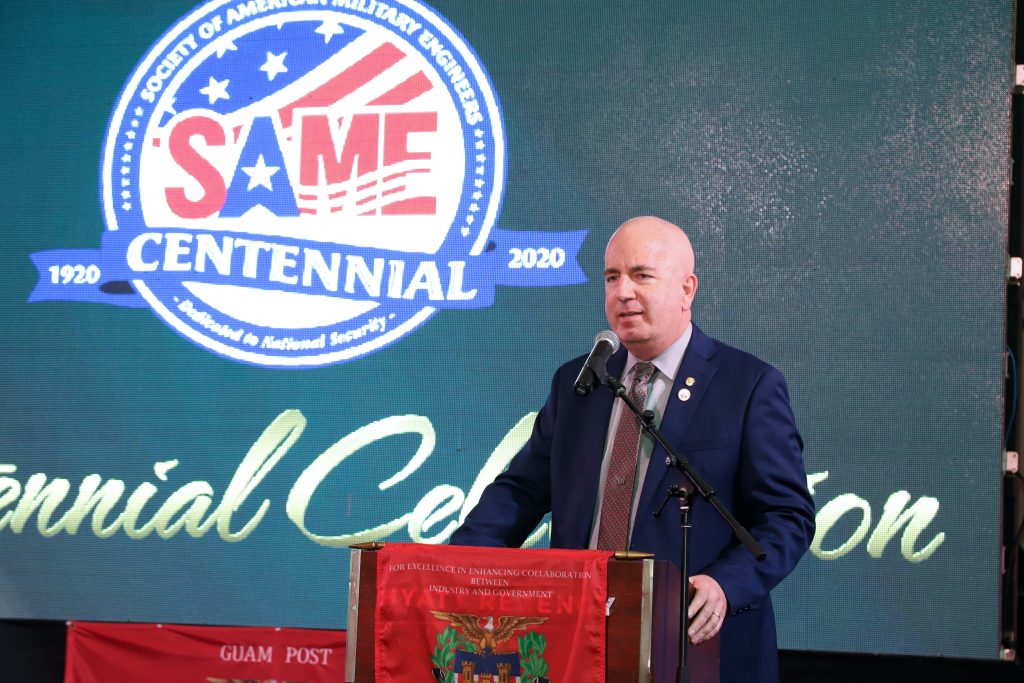
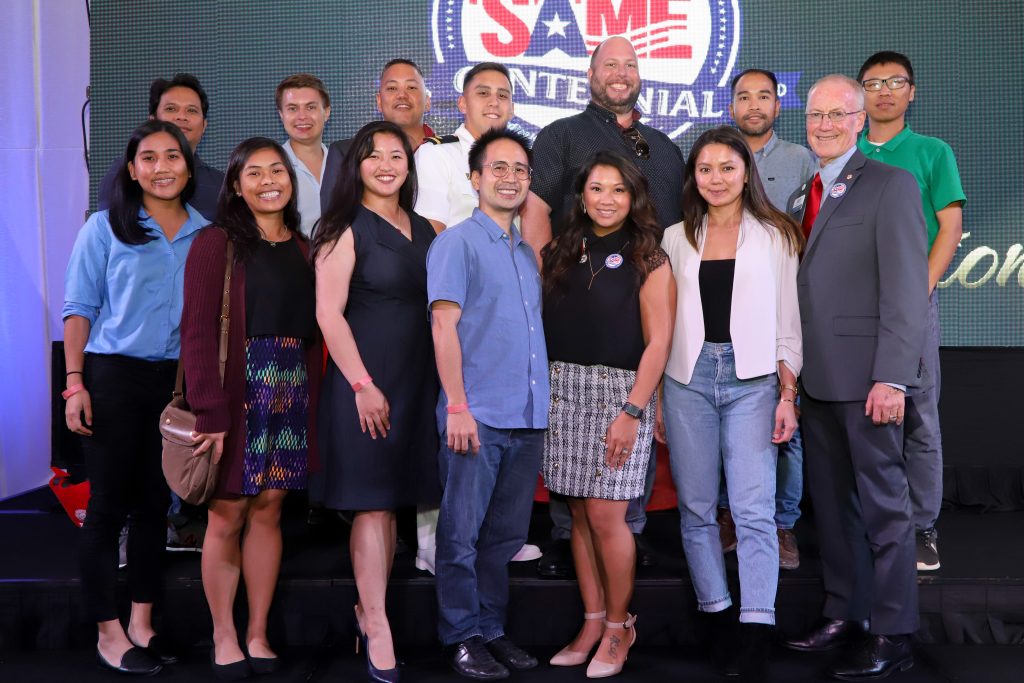



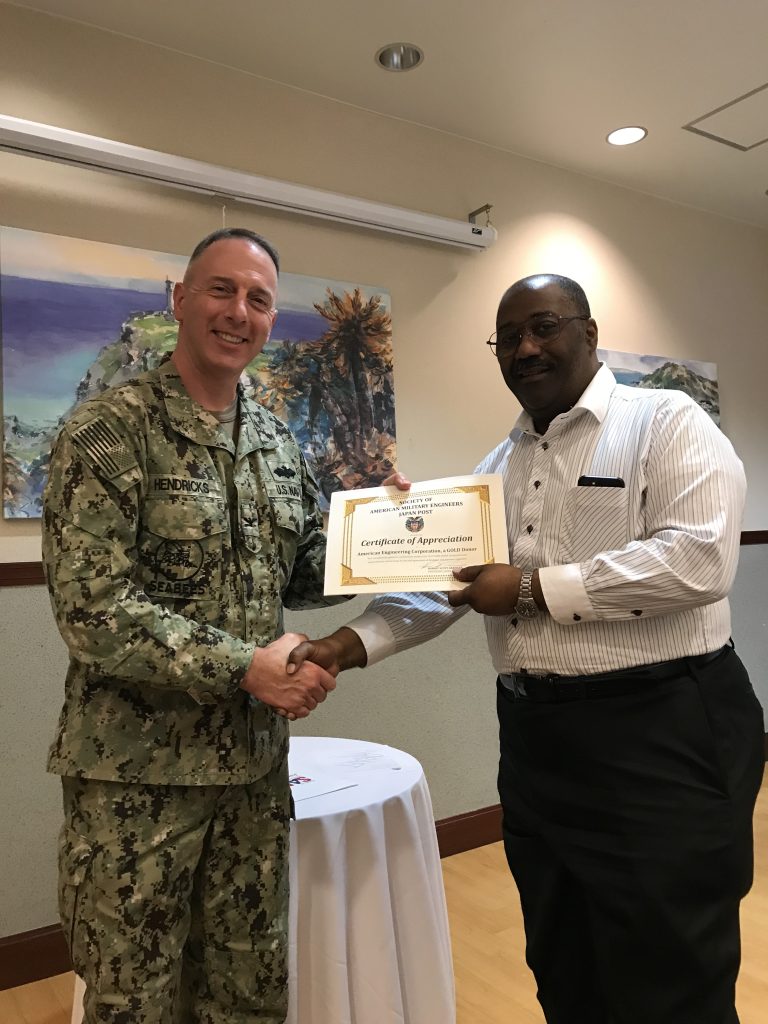
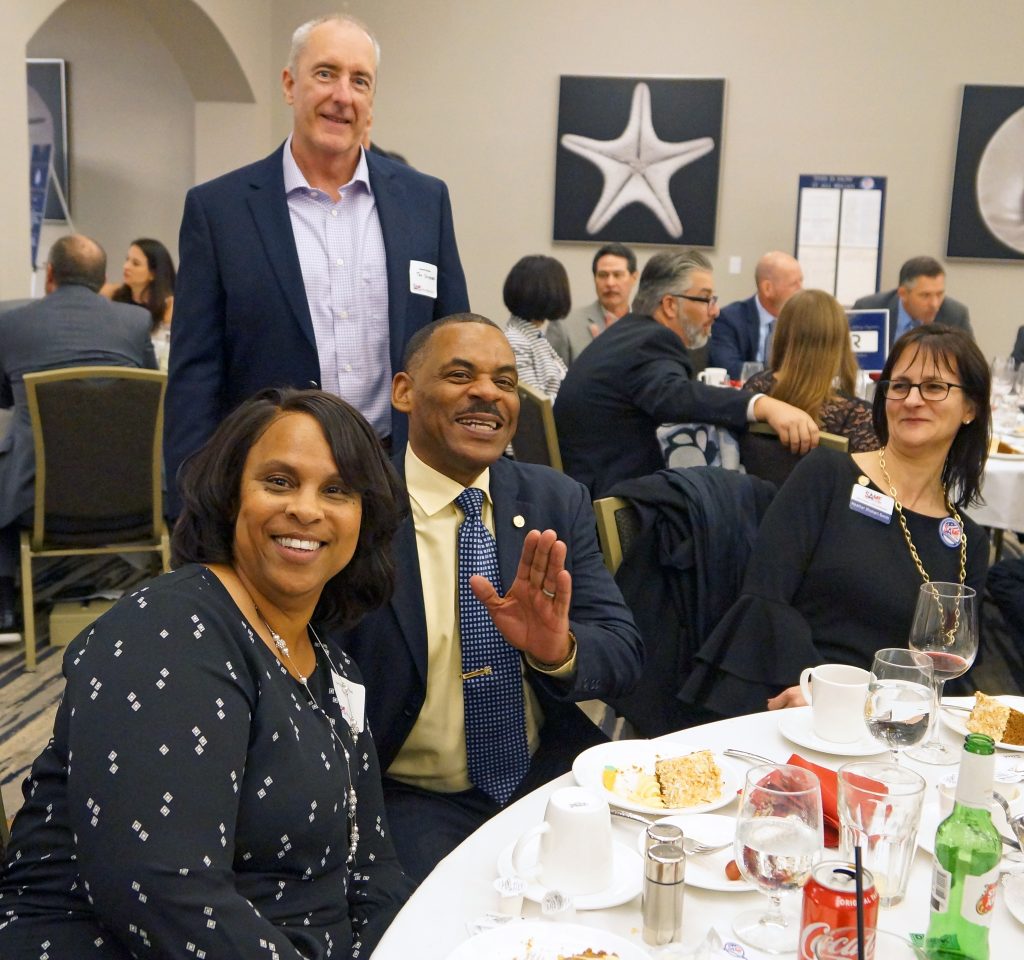

To cap everything off, the Joint Engineer Training Conference & Expo (JETC) in 2020 would be the pinnacle event that would bring all the pieces of the puzzle together and pay tribute to the Society’s rich history. It was a national conference several years in the making.
Joe: JETC 2020 was to be more than “just a party.” It would have a new logo, the first graduation of our national Leader Development Program, historical reenactments, Post celebrations, a major keynote speaker, and it would be the first time the J4 would participate in SAME. Lt. Gen. Giovanni Tuck, USAF, had agreed to be a keynote speaker. I had met him before at one of our STEM Camps and he quickly got on board with what we were working on becoming as a professional organization in our second century.
Ann McLeod, CEM, CAE, Director of Meetings, Membership, & Business Development, SAME (2010-Present): There were definitely a lot of elements we were going to add to JETC because of the Centennial. We usually have the opening reception somewhere special for JETC, so that year we were going to have it at the American History Museum, on the National Mall. We could do some cool stuff at that spot, like have a scavenger hunt in the museum. We were trying to do a lot of special events and historical tie-ins.
Mike W.: One of the centerpieces of this whole thing was a re-creation of Eisenhower’s journey across America, which he did in 1919 around the time of the beginning of SAME, and which resulted in the Interstate Highway System decades later when he was president. The idea was that there would be a JETC in Washington, D.C., in 2020, and then a JETC in Portland, Ore., in 2021. In between those two there would be a series of Post events that took us across the country, essentially following the route the Eisenhower Convoy took.
Jill: One of the other ideas at JETC was to have the older vehicles from the military showcased at the convention center, along with people in period uniforms.
Ann: We were going to do a timeline of the Society with signage, and displays with SAME awards history. There were some different elements we were going to add, like reenactors, and we were thinking about getting historic vehicles into the convention center.
Stephen: There was even an SAME Centennial Song. A member from the Public Health Service wrote the music and lyrics; we then put a video together with images from over the decades timed to the song.
More than just showing where the Society had come from, JETC 2020 would show where the Society was going in the future.

Joe: Having JETC in Washington, D.C., was going to be big. The fact that we had the J4 and the Joint Staff working much more closely with us than they ever had was big. We had expanded from serving the services to working with the Joint Staff, so we were becoming a bigger joint organization.
Ann: We booked the DC Convention Center in Washington back in May 2015. All the plans were in motion for a long time.
Stephen: We had been building toward this. In 2018, at the JETC in Kansas City, Mo., we had the President’s Reception at the World War I Museum. We had T-shirts, we had a Centennial Coin. Our strategic plan was built around this new era for SAME. We published a special TME, WWI commemorative issue, that focused on SAME’s beginnings; we worked on it throughout 2018 and the Army, Navy, Air Force and Marine Corps all provided contributions. Joe and I even met with the Army Office of History to secure their help and involvement on SAME Centennial-related ideas. We’re building energy. We’re building awareness around this singular point; but, the key was, the singular point was not a moment in time. It was really intended to be like a pivot point, to get SAME forward into its second century, not rest on its past but leverage the past.
Caroline: The timing of graduating this first Leader Development Program cohort (May 2020) was so symbolic of how far we had come and the foundation we laid to get here. And then, how can we leverage our history in today’s environment and launch ourselves forward with the LDP. In my mind, that first cohort was part of that pivotal moment; looking 100 years back and the next 100 forward.
Joe: The LDP is a big part of the whole journey. I remember saying to Mike and Caroline, you two go put it together 2016/2017 and then in 2019, we’ll have the first class. So be ready for the first class. Then we’re going to graduate the first class in 2020, and we’ll build the program. Because what SAME is all about for its future is leadership in the industry. So if you’re going to be a leader, in order to do that, you better be developing leaders as well. And we were going to develop leaders for the Society.
Caroline: Joe was a huge supporter, and was very involved especially with the UPICs, and would see what levers he could help pull to make them successful. But at the same time, he sat back and allowed Mike and I to just go with it.
Stephen: We now have LDP by this point. We have IGE. These are full speed ahead as of 2019. The SAME Foundation, which was started in 2016, by 2019 it had started to make some inroads, but it was really still in its infancy. But the first real fundraising push started in 2019 so real progress on what the vision was going to be for the future was in place.
It was all part of our mission to be the king collaborator. We were the ones that were going to pull all the other organizations in, and that event was kind of going to be the embodiment of that vision.
Kathy Off
Joe: When you look at the National Office annual priorities in sequence through those years, you’ll see the specific things that we laid down that they’re not just a list of things that we said we’re going to do. They were the building blocks. Those were the pieces that we envisioned back then, that if we get them in place by the time 2020 JETC comes, now we have the foundation to build the next century of who we want to be.
Kathy Off, PMP, Strategic & Stakeholder Relations, SAME (2006-Present): We had a lot of strategic partners that we were establishing in those years. We wanted to incorporate them into our celebration and in our strategic plan moving forward. We had invited them all to attend the Centennial JETC. It was all part of our mission to be the king collaborator. We were the ones that were going to pull all the other organizations in, and that event was kind of going to be the embodiment of that vision.
Stephen: Each of SAME’s presidents in that time frame, from 2015 to 2020, their themes for the year laid the groundwork to where we were headed. In 2018 the president, Marv Fisher, his theme for the year was Just One More. It was really built around this idea of, if everyone in the Society could do just one more—just one more STEM event, just one more IGE event, just one more member you bring to a meeting; think of all the impact you could have as an organization if everyone did just one more. But it also was just one more year until the centennial. That proved a clever opportunity that we took advantage of messaging wise, and really started to speed up the enthusiasm.
Buddy: Every Post that I visited was planning something for the Centennial. Everyone had their own particular way they wanted to celebrate, whether it was a young post, or one of our original Posts from 1920 that was still around.
Stephen: The way the planning was set up, Cindy and the Centennial Commission also had an entire Post Centennial Task Force as part of it. Dave Newkirk was the lead and every month we had a report from the regions on Posts coordinating their local celebrations.
Part II: COVID-19 Forces Closures
The speed at which the COVID-19 lockdown went into effect was astonishing. At SAME, planning for a busy spring conference season, starting with Capital Week in March, was fully underway when the lockdowns began, essentially overnight.
Buddy: I was at the regional meeting in Tulsa in February of 2020, and that was the last formal thing we did, because right after that, everything just started to shut down. We had 250 to 300 people in Tulsa and not even a week later, everyone is worried about being infected with the coronavirus. Everyone was trying to figure out if we needed to keep in contact with all 300 people and make sure who was sick and who talked to whom. People just didn’t know what COVID was and were terribly frightened.
Ann: In the beginning of March we were focused on our upcoming Capital Week. I remember we were having a staff meeting, and people were starting to ask about canceling their conference registration. Then I participated in this webinar because obviously everyone with events is asking, “What are we supposed to do?” The webinar was being given by the Professional Convention Management Association, and they had an infectious disease expert. After it, I thought, we cannot have Capital Week, even if we’re allowed to. It would be so irresponsible.
Rich: One of our star basketball players on the Utah Jazz popped positive on COVID and suddenly the next day NBA is canceling games. We’re all wondering what does that mean for large gatherings or any gatherings for that matter.
Heather Wishart-Smith, P.E., PMP, LEED AP, F.SAME, F.ASCE, 101st National President, SAME (2020-2021): Capital Week just went away completely; it was canceled with very short notice.
Stephen: Within a week, everything was crumbling down. We had our Capital Week event planned up in Bethesda, Md., and were going to hold it up to the point where we had to cancel it. Almost simultaneously, the venue cancelled on us because there were shutdown orders. So, it ended, just like that.
Ann: The Governor of Maryland banned large gatherings. When that happened, I realized that we have to monitor all these alerts coming out from the D.C. government, as far as JETC was concerned. When the mayor made the shutdown announcement, we knew we weren’t going to be able to hold JETC. We held out hope and waited to make an announcement, but it became clear pretty quick.
JETC was still two months away when Capital Week was cancelled and the nation had, in many ways, closed up: schools, businesses, arenas, restaurants, and entertainment venues. Both staff and members were worrying about life and death, dealing with uncertainty at home and with friends and family. In an entirely non-normal environment, the leadership team focused on keeping things as normal as possible.
Team,
SAFETY: As we discussed at today's meeting, our COVID response plan is carefully measured and timed to make sure we all stay calm, regardless of how bad the situation gets. So, as you read reports (and there are scams out there and misinformation) and track developments, do not react to single data points. We will keep you informed as we gather reliable and authoritative information to anticipate decisions in order to make them at the right time to sustain progress on our missions, preserve our team and preserve the financial integrity of SAME. So, any time you are feeling a bit overwhelmed, or confused, or even afraid, just talk to one of us … you will never be the only one who needs to talk. This situation is far from the severity of many crises that I've dealt with; we will get through this together.
Welcome to Sara Stehle, our new Events Senior Manager and Frankie Hamme, our new Marketing Senior Manager who are onboarding now. Both of these ladies were impressive throughout the hiring process and bring a lot of talent, energy and wisdom to our team. Welcome, Sara and Frankie!! Great to have you in time for the home stretch to our Centennial Kick Off Celebration. See you next week for your New Employee discussion.
Capital Week: Per our plan, we cancelled Capital Week today. Our fortunes are actually looking up: we normally hold the Golden Eagle dinner during Cap Week (so that is not lost) and the Maryland governor ordered the cancellation of all events of over 250 people (that helps us avoid hotel penalties). We will record the sessions and the executive panel next week to make the substance of the conference available to registrants and others who were not allowed to register due to travel restrictions. So, all in all, a great outcome despite the circumstances.
[Email from Joe Schroedel to National Office Staff, 3/12/2020]
Within the span of a week, lockdowns had spread across the nation. Questions about what would happen with the SAME’s Centennial—and SAME in general—abounded in the early days.
Buddy: That was probably one of the most difficult times to get through. What are we going to do? Are we going to give money back? What’s going to happen? We had to ask how to keep revenue coming into your business on one hand, and make sure that we could keep 25,000 people involved in the Society after everything shut down. And probably the largest challenge I saw was in communication, and at the Posts. They were highly at risk. So what do we advise the Post to do? How do they need to operate? How are we going to operate?
Joe: We had just hired Frankie and Sara (Frankie Hamme, Marketing Senior Manager; Sara Stehle, Events Senior Manager). I’d just gotten the paperwork for the final decision, and then, boom, we’re going virtual. The bottom is falling out. We have $5 million or so of liabilities hanging out there for all our events that year. We were in the process of trying to move into a new building and sell our old one (the SAME Century House, which the Society owned and housed the national staff). We had already started the process to build a new Enterprise Management System and putting money down on that ($1 million commitment).
Buddy: You had to worry about your family, you had to worry about your business. Our Corporate Members were not up at night worrying about SAME, and that’s okay. The only people who were worried about SAME were about 25 people working from home instead of in Alexandria. Senior members of the Executive Committee still had our work hats on, trying to figure out what we are going to do and how do we do it, how do we make it work?
Cindy: We were all trying to adapt to remote work. How you connected with individuals was now more difficult. I’m a believer that we have learned a lot better how to communicate virtually. Of course, we have much better conversations when we’re in person, so just engaging individuals to participate and welcome the virtual environment was challenging. I think our national team did a tremendous job researching and helping provide the tools and communication tips for the best way to hold these meetings.
Jill: At that point in the shutdown, I had colleagues in other organizations who weren’t even able to keep the lights on. They were laying people off. They were doing everything virtually and losing members.
In a way, history had repeated itself, as the Society was originally founded in 1920—right in the middle of the Spanish influenza.
Stephen: SAME debuted in January of 1920. The last global pandemic was at that exact same time. So again, we have these parallels with our founding years and our second century kicking off, and we have a once in a century pandemic now hitting again.
Rich: The team in Alexandria and the Board of Direction was helping guide people to remember that this Society was born during a pandemic and that we will survive this pandemic. That tone was set by the National Office. The signals coming from Alexandria were, hey, we’re strong, and we’re going to make it through this.
Mike W.: We were going to cover JETC in Washington, D.C., and then the trek across the country as represented by the various Post events. The book would be given out at the Portland JETC in 2021.Then, COVID hit. All those plans fell apart. It became clear that the march across the country, Post by Post by Post, was not going to happen. Even if you could hold an event, you weren’t going to be able to gather people together to do whatever the Posts were going to do.
As the lockdowns persisted, prospects to hold JETC in person faded. The decision to move it to virtual was anything but certain. SAME had never held a purely virtual event on the national level, especially one that had been envisioned to be the capstone of three years of Centennial planning and a celebration of 100 years of engineering history.
Belle joined a webinar about the subject of virtual events, and she said, “I think we can do this. We can do something.” I said, “Really, do you think so? Do we have enough time?” And she said, “I really think we can pull this off.”
Ann McLeod
Ann: We were in this limbo period because there were two months or so between when we found out we couldn’t do JETC in person and when the actual event dates were. What are we going to do? Are we going to try and do a virtual event?
Heather: I had this countdown because we all thought it was going to be two weeks or so. We didn’t realize COVID was going to be a couple of years. And so, we kept waiting to see. Do we think we can have the event? We just assumed that we would be able to have it, because in March it was still two months away. And then, as it got closer, we had to make the decision to go ahead and have it virtual.
Stephen: The parallels to SAME’s founding were happening all over the place. For better or worse. Back in March/April, JETC hadn’t been canceled yet but every day it was a another check among the leadership and the staff and the directors and Joe, you know, what are we going to do? And that’s in that timeframe when Anne, Belle, Joe and others decided that we could pull off a virtual JETC. I don’t think any of the rest of us knew what that really meant. It would certainly be a lot for everyone to pull off in what ended up being less than two months.
Ann: At that time, Belle and I would get on the phone and go for walks outside, just talking. Belle joined a webinar about the subject of virtual events, and she said, “I think we can do this. We can do something.” I said, “Really, do you think so? Do we have enough time?” And she said, “I really think we can pull this off.”
Belle: We didn’t even have time to think. We just knew we had to do something. We could not become irrelevant.
Buddy: We had to figure out how can we change and turn this into a virtual conference. What do we need to do? I don’t think we’d ever had something like that before. So we had to figure out what we were going to do.
Heather: I felt as though I had a duty to multiple stakeholders. To the staff to help represent their beliefs and concerns, to the membership, and to the financial health of the Society. With so much of the revenue coming through conferences, that was a really big concern.
Belle: It’s unfortunate that the local events didn’t happen as planned at the time. I think a lot of the Posts ended up doing something afterwards. But the initial plan? Never happened. Just done. It’s like you’re training for a marathon, but you don’t actually get to do it.
Beyond just the details of a never-before-attempted virtual national conference with potentially more than 2,000 people participating in real time, there were questions of governance matters that take place at JETC each year.
Buddy: How do we change presidents? What do we do for the change of board members? We have the Board of Direction meeting that goes on at JETC. All of those pieces had to be solved, from mid-March to May. It was probably the busiest time in my presidency, just trying to keep up with numerous conversations, almost on a daily basis.
Rear Adm. Mark Handley, P.E., F.SAME, USN (Ret.), 102nd National President, SAME (2021-2022): Buddy and Heather would end up turning over the presidency on the computer screen, at Virtual JETC, and then that entire year was virtual. And then I turned over as president with Heather, again, virtually. Heather was the first president that actually never got a chance to take the national stage because everything was virtual. So the when I turned over at JETC the following year to Cindy (2022), before I turned it over, I invited Heather up to the stage to give remarks, because she never had a chance to speak to SAME in person while president. It was a long two years!
With a decision to move the 2020 JETC to a virtual event, volunteers and staff dug deep to solve the challenges that such an undertaking would entail.
Frankie Hamme, Marketing Senior Manager, SAME (2020-present): I was hired as the senior manager of marketing literally the day before the office shut down and we went virtual. I had to rely on other people and not be afraid to ask for help. JETC was the first SAME event I was working on, and it was completely virtual in the world of COVID.
Ann: We all realized that we are very adaptable and flexible. Of course, pivot was the word of the day. I think everybody wanted things to work out. We have very high standards. Even if things went wrong, we were really happy with everything the way it went.
Belle: I was on a dry run with an environmental session for the virtual event. I was doing all the talking and directing to prepare the panelists, and then suddenly, all the alarms went off in the house! One of the speakers said, “Can somebody shut up that alarm? That’s so annoying.” And I turned around and said, “You know what? I think I need to shut that off myself, because I believe my house got struck by lightning.” Soon, the fire brigade and everyone came running into the house. The lightning had hit three houses, but I was the hardest hit, and the tree in front had been destroyed. After I finished all of that, I went back to check on the dry run, and it was still going on!
Jill: One of the things those of us here learned is that you can stretch yourself to do what it takes and do something you would normally never, ever do. For example, our logistics specialist (Otis Carter) had a really great speaking voice. We realized we could pre-record videos to show while people are filing into a virtual session, and he did the voiceover. He was like, the voice of us.
Belle: I used to report to Joe at that time. Every morning, we had a call at 9am. Every. Morning. Kathy, Eddie [Gonzalez] and I. What did you do yesterday? What are you doing now? What are you going to do today? It was like, okay, we’re working!
Joe: Our people had the confidence that they were going to be fine. I said don’t worry about it, let’s just go, go, keep doing our job, and we did. They just went above and beyond. Worked their butts off day and night, seven days a week. And I never had any doubts.
Part III: The Show Must Go On
With a motto of “building the plane as we fly it,” SAME committed to delivering not just a virtual 2020 JETC, but also delivering value for members in the virtual environment.
Stephen: No one had any idea what it was going to look like, but we knew by this point that the Centennial Celebration we had spent several years planning and building our entire organization’s strategy around was not going to happen. Instead, we got something that probably was better, because it forced us to adapt, and it forced us to look in the mirror and say, “What and how do we provide value for our members?”
One of the speakers said, “Can somebody shut up that alarm? That’s so annoying.” And I turned around and said, “You know what? I think I need to shut that off myself, because I believe my house got struck by lightning.”
Belle Febbraro
Frankie: I remember working with Stephen in developing the tagline. We came up with maybe three or four different options that we presented to Joe, and we landed on Adapting for Today and Tomorrow, which was really, really key for that age of COVID and this event.
Jill: We wanted to be able to give folks a break since they didn’t know whether they were going to still be in business the next month. So we gave out extensions on membership for some of the companies that requested it, and I think they were grateful. The fact that we were willing to be flexible, we wanted to support them in an uncertain time really connected with them.
Rich: We are such a traveling society to begin with, you often can’t be at a place you want to be. Some of our local meetings, actually had more participation than they would have otherwise had because someone’s on a business trip or a military TDY. Involvement with the military was pretty high because people couldn’t physically travel, which is sometimes difficult.
Frankie: Everyone was affected in one way or another, no matter what your position was. But my role, as a marketing person, I had to pivot. I had to be agile. I had to be flexible in terms how are we going to get the marketing out for this and I have to rely on a new set of co-workers or new team learning everything about the event in like record time. We launched a new e-newsletter during this period, SAME This Week, which was very helpful in staying connected with members. It also included whatever business/contracting information we could gather so that it was also useful for the membership at an extremely fluid time.
Cindy: We were always on a mission to find ways to continue to bring value to the members. I think the pandemic forced us to accelerate our efforts, and we had to find ways to pivot in support of our Posts, especially, because they were the ones that were going to struggle the most during COVID. It’s hard if you lose your membership to bring them back.
Making the decision to hold the 2020 JETC virtually was by no means easy, but the work that came after that decision point was even harder. Logistical details and training staff and volunteers, compounded by the challenge of the remote working environment and personal issues both members and staff were dealing with daily, had to be solved in only a few weeks.
Ann: What we did was we surveyed all the speakers and asked, “Are you willing to still present your session virtually?” So we did all these surveys to figure out who was in, who wasn’t in, and then we had to determine if we had to redo the schedule. We went from this period of being in limbo, to this period of we’re all just working so many hours to try and figure it out and build this virtual environment.
Belle: Ann and I had this discussion early on about if we can do just 20 sessions for the virtual JETC. I said, “Ann, I think we can do more than that.” I reached out to all the speakers who were accepted and explained the situation and asked if they were willing to provide us with a virtual presentation instead of just not presenting at all, and everyone was really obliging. We ended up with 46 sessions for JETC 2020, which is huge.
Frankie: Having to build the marketing plan was significant and one of the outcomes was that that we weren’t trying to salvage the event, this event we had positioned as a flagship milestone. We weren’t trying to salvage it. We were trying to use Virtual JETC as an opportunity, basically, to retool.
Mark: I would tell you that the SAME national staff had a pivotal role in making our success during that year. As we say, they were building the plane as we were flying it. They were figuring out how to do it virtually. What’s Big Marker? (the virtual platform SAME used for Virtual JETC). How do you do a virtual conference? How do you do Q&A? They did a fantastic job of transitioning that.
A major challenge facing the planning and preparation was government firewalls. With many of the emerging popular options for virtual conferencing unavailable for those on government computers, SAME needed to find a way to let government attendees be engaged. A new conferencing software, Big Marker, was the key to success.
Joe: We heard about this system called Big Marker, and that it can be used by people with government firewalls since it’s all web-based. That meant that people inside the Pentagon or inside an installation could participate. It turned out Big Marker was hugely key to JETC 2020.
Kathy: It was a pretty new platform, and everyone on staff had to learn the technology very quickly.
Belle: We now use Big Marker for our webinars, and that was because it was used during the virtual times and we realized, well, why not just continue with that same platform since that’s what our folks were used to?
Heather: There were some things that didn’t work out quite right, since the technology was so new. But Big Marker was really good.
Belle: Lawrence with eShow was definitely one of those who really spearheaded this, because he was having to learn a lot of stuff first, the websites, the integration of Big Marker, and then work with us so that we became proficient in it.
To get all the work needed for the virtual event completed in a very short timeline, SAME adopted an all-hands-on-deck approach. Staff pulled together to prepare attendees and speakers, learn how to moderate panels, and provide technical assistance on the fly. It was everyone on staff, regardless of their position.
Belle: We had lots of new people on staff, like Frankie. She was hired as our Marketing Manager, and she didn’t even get to market anything typical for a whole year! Instead, she was having to learn really fast how to do webinars, how to be backstage during a virtual event, and how to check the scripts to make sure everything is right.
Frankie: I think only three or four people could come into the office at one time. The whole staff had to pitch in. We had to do dry runs with all the speakers and make sure that we were up to speed on the technology because it was new to us as well, and, you know, anything could happen with technology. We had to be the experts really, really quickly.
Jill: I think COVID definitely brought people out of their silos, maybe even just because they wanted that human connection to people that you work with. You may not actually do work with them, but you were used to seeing them every day and now all of a sudden you’re not. We did a couple of virtual happy hours and things like that. But I think the fact that everybody had to pitch in, particularly for the events, kind of broke down some of those silos and got people thinking and engaging with each other more.
Frankie: In the end, I learned how to do something different. I would say that I was able to learn a few things, not only as a marketer, but also about the event and about the people that I work with and their firms, their staff, and about the attendees, because they were fabulous.
Heather: There was a lot of excitement about JETC 2020. It was probably the largest and first virtual event anyone had attended. Many other organizations had not yet shifted to virtual, so to make it engaging for the audience was a challenge. But it was more lively than most had seen. JETC was one of the first to really do a good job with the virtual environment. The membership was really excited about it.
Rich: I have a dim memory of a disappointment of not being there in DC, but there was excitement that we were doing something.
Mike W.: The hard work in terms of having to adjust to COVID was really the staff. But Stephen and I spent a lot of time figuring out, what we wanted to do to honor the Centennial. We’re not gonna be able to personalize it the way we hoped to. We’re not gonna be able to cover the Post’s activities and show what were going to do. How can we compensate for that?
As the day of the virtual conference approached, details were being finalized up to the last minute.
Frankie: It was truly a learning experience, and it was scary. At the same time, though, it was exciting. But you know, we had a goal to reach and we had to make sure that our attendees were not going to forget about JETC just because the world ended.
Kathy: Everyone had to do something technological, whether they liked it or not; but it turned out really great. I remember everybody just worried about how we were able to pull this off without a hitch. Other organizations just had to cancel and probably eat some fees or refund a lot of money. And we didn’t have to do that; our members trusted what we were doing. That’s pretty amazing.
Joe: The day that we went virtual, I had gathered the team, and I said, “We’re going to finish the year at least as good and make budget. We’re going to do great. Don’t ask me how. I don’t know, but we’re all going to do it together.”
Hello Team!
16 days and counting until VJETC kicks-off. Thanks for everyone’s teamwork today, tomorrow, and the next three weeks. We need everyone to please pay close attention to all the information that is being sent out and have patience as we continue to build the plane as we fly it. Believe me we are trying as hard as we can to be organized but…
Attached are UPDATED staff assignments. You will see the “session grid” and also one “by individual” so it is easy for you to know what you are doing each day. There have been updates since last publication due to some session changes and such. Please review and let me know of any questions at all about your assignments.
As you know, we’ve said since the beginning of the year that Memorial Day is a work day for staff. Monday the 25th and Tuesday the 26th we need everyone to do a whole bunch of quality control, making sure all presentations have been received for your sessions, following up with speakers (we will train you on exactly what needs to be done). Usually this is done in the speaker ready room on-site. Everything is truncated and not as easy as in-person, so we are relying on you to execute this with us. These are full working days for everyone. I am sending invites to two staff meetings so you have all the information you need and also training on the webinar platform (Big Marker).
We are planning a series of “training & orientation webinars” for both attendees and speakers so they can get familiar with the Big Marker platform in advance. The more familiar you are with everything before we have the staff training, the better.
Thanks again team! Let’s go 1-0 today, and every day until 4:30 pm on May 29, to accomplish this which will bring so much value to our members!
[Email from Ann McLeod to National Office Staff, 5/11/2020]
Success was assured because the certainty that everyone was in this together, and that everyone who was part of the event was pulling together to make it a success, even when problems arose.
Ann: Anything that could go wrong did go wrong. Before the first general session to start the Virtual JETC, we got everybody on to check the communications and that everything was working. And, of course, everything worked fine. But then during the live session, people’s connections dropped. I think we had six different engineering chiefs from different locations trying to go on; General Semonite was at our offices for better connection (Lt. Gen. Todd Semonite, USA, U.S. Army Chief of Engineers and Commanding General of the U.S. Army Corps of Engineers), but he was in a room by himself due to social distancing—and then his machine isn’t working. That was so stressful. But the audience stuck with us.
Caroline: When they first started the meeting, I saw General Semonite sitting there, but something’s not working, and then suddenly I saw Ann going into his office to help him. I happened to take a picture of the screen at that moment, and I sent it to her, and she said, “Yep, we’re building the plane as we’re flying it!”
Ann: We had something like six different chiefs in that session. So much shifting between cameras and speakers; Big Marker was great, but it was not ideal for that many presenters. General Semonite was in our office and something started to not work, and he was trying to get it back, pressing buttons. That’s when I ran down the stairs and that picture of me in the room, trying to see what was wrong. I couldn’t fix it either, and I said something like, “Sir, you need to just come upstairs and sit at my desk.” It was like that all the time; anything that could go wrong did go wrong, and people’s connections would just drop. But that’s technology, right?
The next day was just as challenging, with keynote speaker Mike Rowe, and a change of presidents for the ages.
Heather: In the middle of the interview with Mike Rowe, the reporter from ENR (Jeff Yoders, who was conducting the interview) lost his internet connection and couldn’t get back in. So, I just jumped on and continued the interview. I’ve gotten a lot of comments, even years later, of people saying “Wow, you stepped in so seamlessly.” And I say, you have to have a backup, you just never know what might happen.
Mark: We had this several times between Heather and I, when my internet didn’t work and the other had to step in for a moment. I know Heather had to do that at least once or twice. It requires having a backup who is not only online but also paying attention, so if there’s a gap, they step right in. And Heather did that probably better than anybody. She stepped in a couple of times, and she really, really pulled it off and made it look as smooth as it could.
Buddy: We found someone who could make a Centennial Cake. And my wife and I put together a short video of blowing out the candles together. And then when Heather was supposed to be putting the Past President’s Medal around my neck, my wife, hiding behind me, was doing it while we went on with the speeches that occurred. Of course, the computer went out right then and so no one even saw the medal being put on! But, you know, we found a way to transition leadership. We found a way to transition the board. That wasn’t as hard because it’s not a highly visible activity. But transitioning to the new president is a highly visible activity at JETC.

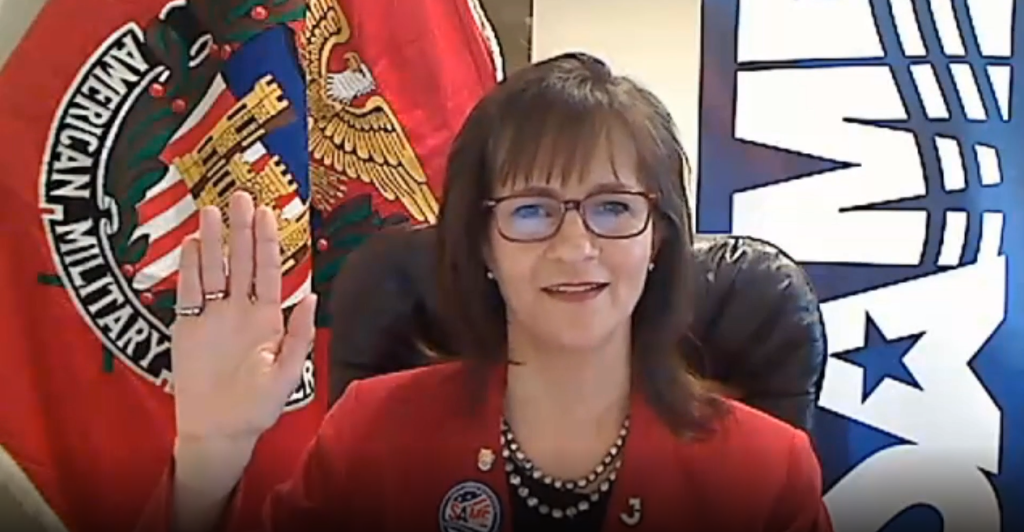
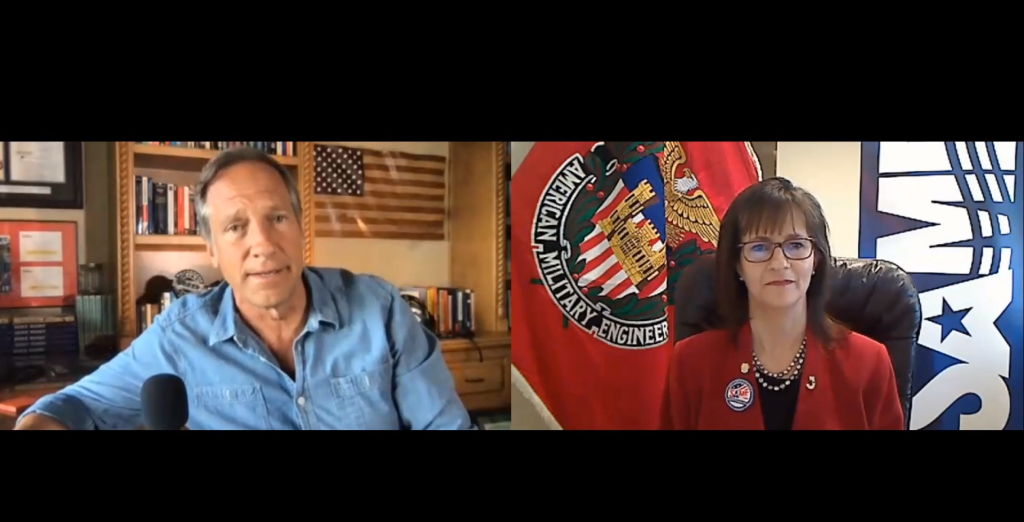
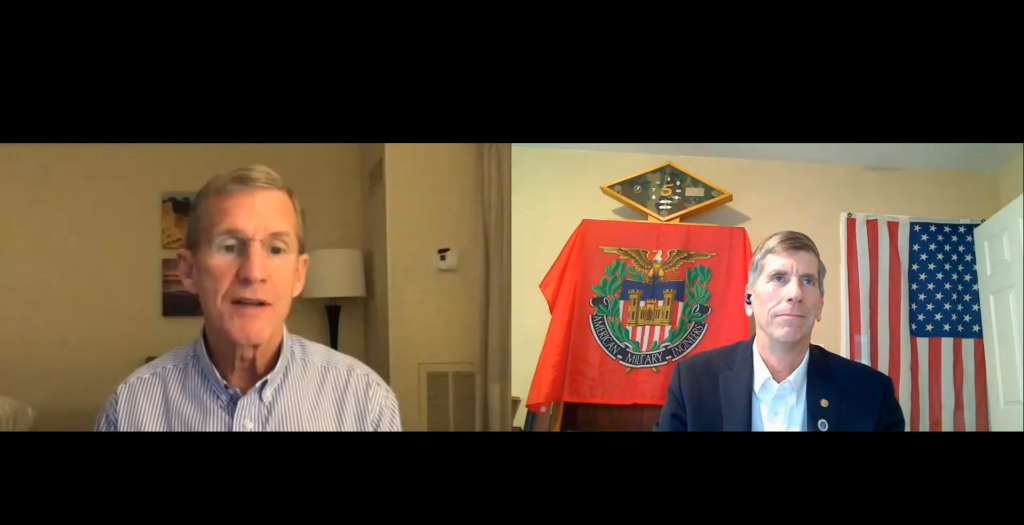
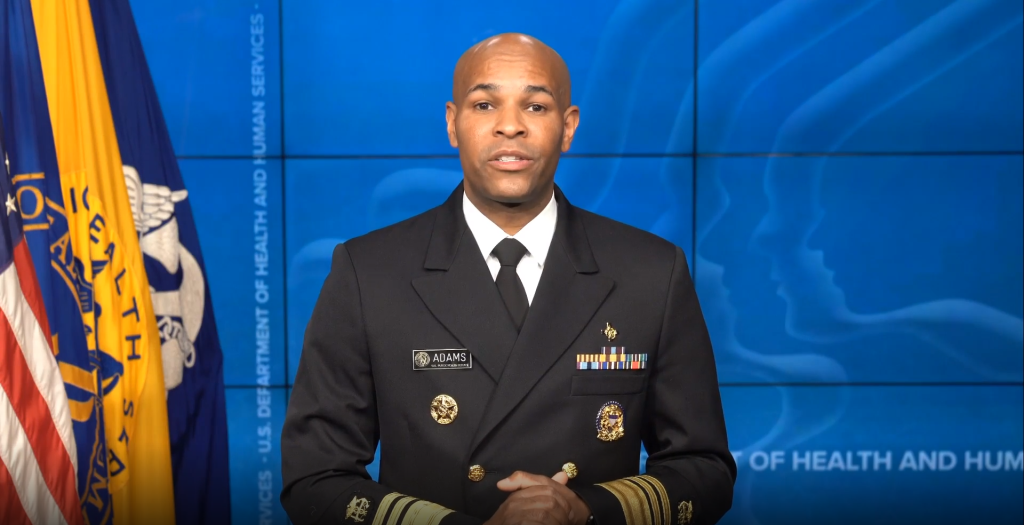
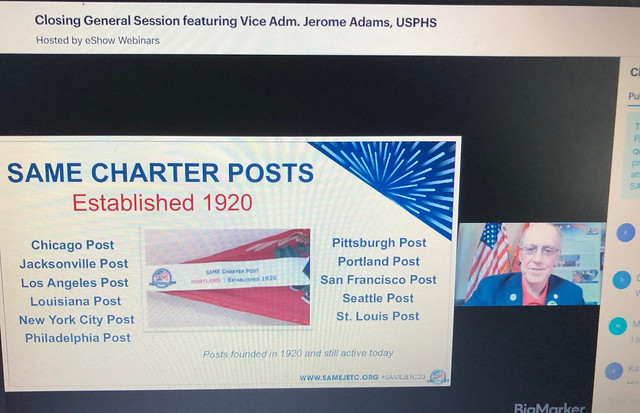

Though it wasn’t the Centennial Celebration as originally envisioned, SAME members came out to attend the virtual JETC from across the world, seeing the silver lining of increased accessibility in the virtual world. Members fell into the spirit of the event by posting to social media with the hashtag #HowIJETC during the virtual JETC.
Ann: Overall, it went off really well. I was reading some of the surveys recently from JETC 2020. A lot of people were like, “you know, this was great; of course, I prefer in person, but there was a lot of information.”
Jill: One of the things that those of us were here learned is, you can stretch yourself to do what it takes, to do something that you normally would never, ever do.
Ann: In general, we all realized that we are very adaptable and flexible. Of course, pivot was the cliché word of the day: but it was also true. And I do think our membership really appreciated that we tried our damndest to provide something of value. And to me, one of the biggest kudos that we got, that I was so proud of was, because we had a year-and-a half that we weren’t doing in-person, someone said to me: “you guys have done this the best out of everyone, and so we’re not participating in any other virtual events except for yours, because it’s just not as good.”
Rich: People were using their imagination to get the participants more involved right from the beginning. That was neat. Of course you had to arse parse it into many different rooms. Thousands of people aren’t all going to work together on one screen. I think the team did a great job of herding the cats and having room leaders. There was a Board of Direction person in each sort of venue is my recollection and it made you feel like you were interacting with some of the national leadership team.
Caroline: We kicked off the new LDP class. We did the best we could, but we made it work. Everybody was just doing the best they could.



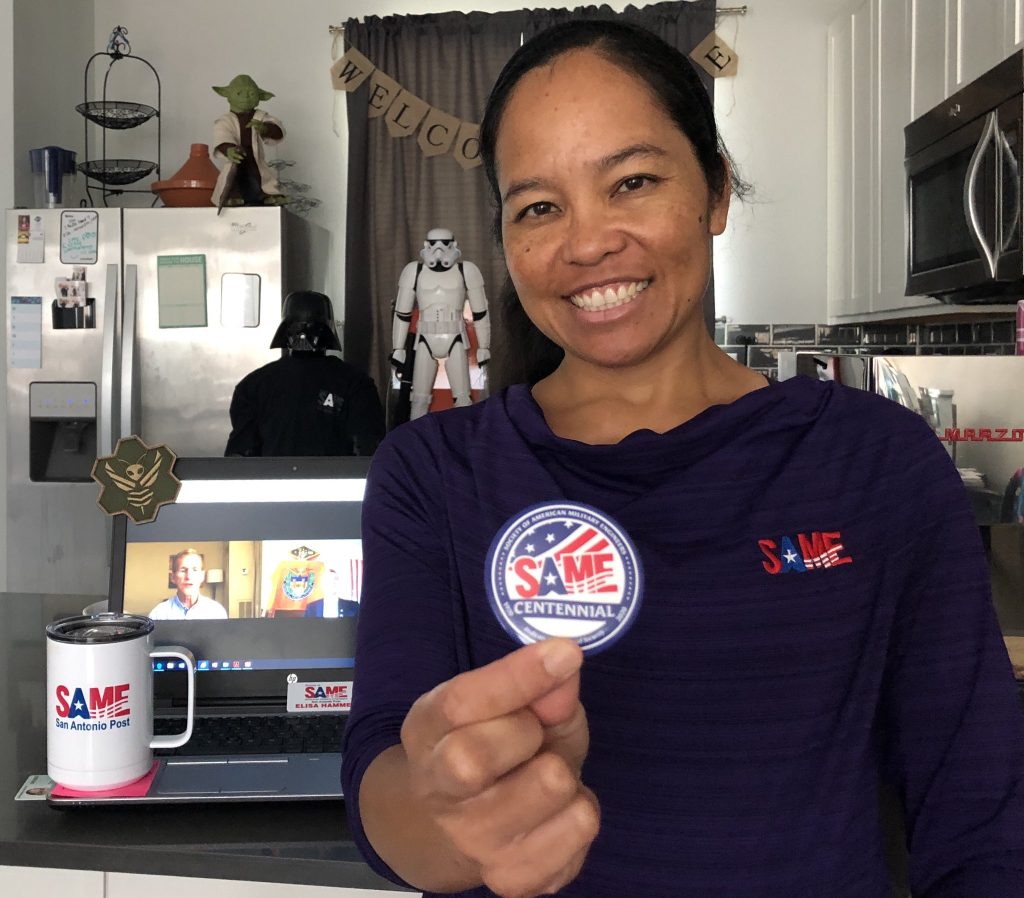
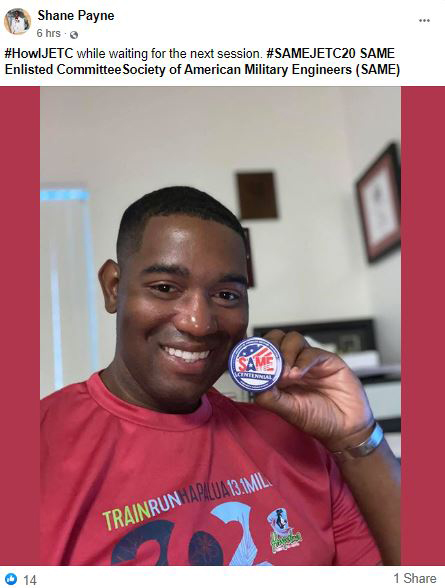
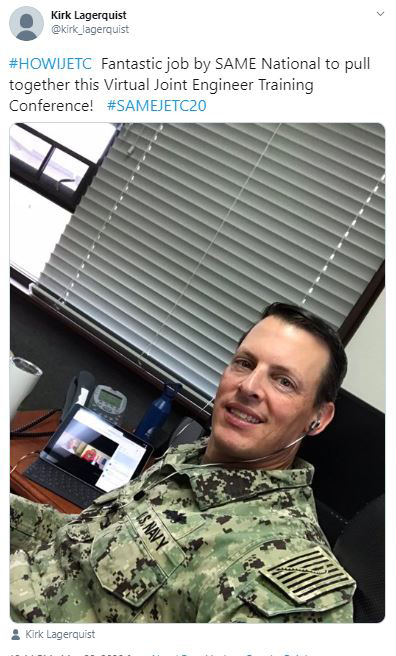



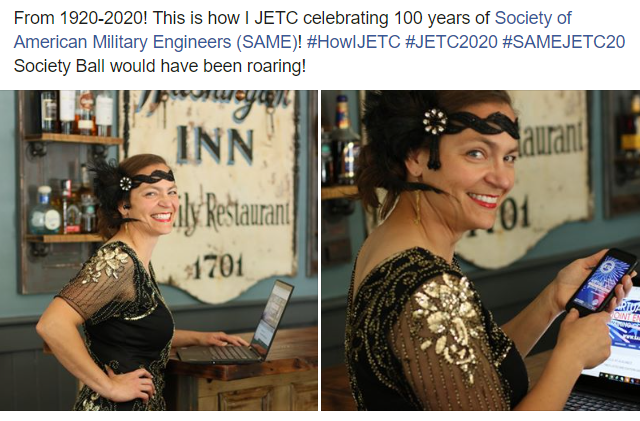
Despite the myriad difficulties and scrapped plans, Virtual JETC was by many measures a resounding success. More than 2,100 attendees joined the virtual sessions and discussions during this unprecedented event. Participants lauded the staff for their efforts and provided positive feedback on the conference.
Mark: I just recall that at every turn, whether it was registration or logging in, how are we going to be able to ask questions of speakers, how are we going to respond to those questions? We are all in new territory for the staff and those of us who were part of it behind-the-scenes. I would say they did an exceptional job. They didn’t panic, because you could have easily panicked of that, and they just solved the problems one after another.
When they first started the meeting, I saw General Semonite sitting there, but something’s not working, and then suddenly I saw Ann going into his office to help him. I happened to take a picture of the screen at that moment, and I sent it to her, and she said, “Yep, we’re building the plane as we’re flying it!”
Caroline Roberts
Jill: We had over 2,000 people attend three days online, which was pretty amazing. Staff were doing roles they never had to do before. Everyone was managing sessions, and that meant you’re doing the job that Belle and the programs team that work in the speaker ready room normally do on site. Now, we’re all doing that and running a session. Yeah, who had any idea how to do that?
Ann: We tried to put staff in teams of two for managing sessions, and it was because you’re at home, I’m at home. This is before Zoom and Teams calls were so commonplace. Like, all of a sudden your internet might go out. We realized we had to have backups. Then you realize, everybody had to share their phone numbers. And we said, “Okay, everybody, you have to get all the speakers in your session, you have to have a text string. Everybody needs to start a text string.” It was contingency one, contingency two.
Heather: The staff really did a fantastic job of of making that transition and doing it in a very creative way. There was a lot of excitement about it. It was probably the largest, and first virtual event that anyone had attended. I do think people were really excited. There was a lot of engagement in the chats. I have a couple of screenshots from the chat and stuff that people had either sent to me or I had taken. I think people had not yet been worn down by the virtual world. Fast forward a year, and the second virtual JETC, people were kind of worn down by then, just screen overload and tired of being stuck in their homes. There was still, in May 2020, a “we’re all in this together” kind of vibe.
Belle: We had higher attendance than anticipated, and the attendees were so grateful. So we still remained relevant to the Corps of Engineers and other government agencies, the mission, and everything else we wanted to do.
Stephen: Virtual JETC 2020, looking back, had quite the lineup. Mike Rowe, every service chief, the J4, Stanley McChrystal, who led U.S. Forces – Afghanistan, and Jerome Adams, U.S. Surgeon General. During the apex of the COVID outbreak, we were able to have the Surgeon General provide remarks to our membership and underscore the importance of the engineering community (and SAME) to the national response efforts. That’s pretty cool.
Caroline: They somehow did it, and did a remarkably good job, I’m sure it was not easy to pull off Virtual JETC, and they did it very well: staff, presenters, volunteer leaders, everyone. I’ve experienced all of that, so I assume a lot was going on in the background. You’ve got your kids homeschooling, coming in and out, but it was professional. It was good. I imagine it was exhausting, as it was exhausting just sitting looking at a computer all day!
Part IV: Let’s Call it a Win
Though the Society didn’t know it at the time, Virtual JETC was the first step in a journey of transformation. Lessons learned from the event, new capabilities and technologies, and re-forged trust with members and stakeholders carried through the next challenges of the pandemic—and beyond.
I think people had not yet been worn down by the virtual world. Fast forward a year, and the second virtual JETC, people were kind of worn down by then, just screen overload and tired of being stuck in their homes. There was still, in May 2020, a “we’re all in this together” kind of vibe.
Heather Wishart-Smith
Buddy: The aftermath, I think, is interesting. We kept a number of things that we did during lockdown, like having a virtual board meeting. It’s grown in attendance because people didn’t have to travel in a city like Houston. You had a board meeting that preceded, in most places, your monthly meeting, and they were able to move it to a different day. You didn’t have to spend your whole day at an SAME board meeting.
Rich: You can never replace that in-person experience—high fives or hugs or handshakes or just eye to eye contact. There’s a sadness to not being able to have that human-to-human connection, you know. There’s a little spark missing. But we proved that we can gather and teach and interact and share virtually.
Frankie: Personally, I learned that as a marketer you always have to be flexible. You always have to be agile. You have to be ready to make any type of adjustments because anything can happen. A keynote speaker could drop out, or you plan on having an in-person event and all of a sudden it’s virtual and then the technology changes and your tactics change. It taught me to not panic and understand the assignment and do what you have to do.
Heather: It helped the Society tremendously to not have to just give up that revenue and interest in the conference. Because if we had just canceled it, I think people probably would have had other things to do with their time, and maybe the Society would not have come out of it as strong. I think that having the Virtual JETC and then a Virtual SBC in the fall were really beneficial in the long run.
Joe: Everybody stepped out of their wheelhouse, out of their comfort zone. I never once lost sleep over it. I mean, I was tired because it was long and hard, and everybody had that experience, but we all had the faith and confidence that we would do it. And I think the Society knew that, that what our team was all about, plus they recognized the things that we were doing, like the LDP and the Foundation. I think in this period we really gained the confidence of the government agencies and the military to participate freely.
Stephen: Within our department, communications and marketing, finding opportunities to tie our past to our future became a focal point of everything we did. Our past is part of us, but our future was so clearly connected to that past. The way it worked out affirmed we still have a lot of runway ahead of us as an organization.
Over the next year, the motto “thriving, not surviving” became manifest. With the takeaways from the Virtual JETC in their pocket, and an invigorated membership following a clear strategic direction built around collaboration and industry-government engagement, SAME looked ahead to what was coming next.
Jill: I think once people do get engaged with SAME, they become pretty loyal. They realize that there’s value here for them in their day-to-day job—they’ve made connections that are no longer just colleagues or were a client. They become friends, and you will often hear people refer to SAME as family. It’s definitely a moniker I hear more than pretty much anywhere else I’ve ever been.
Kathy: Honestly, for me, it was relief. For the staff, there was a sense of relief. Having to pivot was huge, and there were a lot of headaches along the way. But I think that it propelled us in a in a new direction that was beneficial in the long term with new technologies and setting us on a path towards collaborating in new ways. We’re still seeing the benefit of that.

Ann: For SBC that fall, we took the lessons learned and figured out what needs to improve. And luckily, our vendor eShow, they were also building upgrades. We tried to add elements to enhance the person-to-person networking. We had contests for people to visit booths, we had a trivia contest where people could only figure out the answer if they visited the booths. It’s like virtual booths. The virtual event interface completely changed, from JETC to SBC. We had a magician during an online networking social. We had a DJ contest. We were all relearning again and again, learning a whole different job.
Mark: The CEO of the Dallas Mavericks was one of our keynotes at SBC 2020 and got us all up on the screen, me, Heather, Joe. Each of us in our different rooms virtually. That was a highlight for us, doing the cupid shuffle. The video is something. We had fun with it.
Cindy: I think about how far we’ve come in the few years since. SBC 2024 had over 6,000 people. Amazing sometimes to think back to how that virtual period kept the momentum going.
Rich: With the one exception of people not knowing how to unmute themselves, video conferencing turned out to be a pretty good tool for busy people!
Along with the basic technical details, replicating the excitement of an in-person exhibit hall for the virtual environment was no simple task. This was a focal point to improve for the next virtual events.
Frankie: We wanted to make sure that the exhibitors had a presence. We had to make sure the virtual platform was engaging and the overall marketing strategy was well focused and well planned, and that the whole experience was elevated. In fact, that was the theme for the 2021 Virtual JETC the next year, An Elevated Experience.
Ann: There was chat functionality within the virtual exhibit hall by the fall SBC and they could show videos. We had contests for people to visit virtual exhibitor booths, and we had a trivia contest that people could only figure out if they visited the virtual booths.
Stephen: I remember we produced all kinds of short SAME commercials for the virtual platform once it was clear we would be in this environment for a while. We had welcome video messages from sponsors, from SAME leaders. The “exterior” of the virtual conference center had signage for the event. We even had videos from celebrities. Cameo was big at that point, where you could hire celebrities to record videos for you. We had Peterman from Seinfeld welcome attendees to an event. It got pretty sophisticated.
As stay-at-home stretched on, SAME would adapt the 2020 SBC and the 2021 JETC to virtual events as well as Capital Week, Post Leaders Workshop, Fellows Investiture and more, building on the foundation set by that first virtual experiment. With each iteration, the experience would elevate even more, providing value for members in an uncertain time (but in time, the urge to get back together in person would become very apparent).
Caroline: The first cohort of the LDP still graduated, but it was online. It was still good, but it was like getting dressed up in your best and then sitting in your living room.
Mike D.: General Semonite had volunteered to be the keynote speaker at the virtual LDP graduation. He was going to do it live; then, due to COVID requirements and other duties, he was called away for a series of meetings at the Pentagon and the White House. He worked with his HQ team to tape a video presentation. I know getting the presentation was down to the wire. While it wasn’t what we had intended, having the Chief of Engineers keynote the graduation helped make it still feel special.
Stephen: That fall we did the Fellows Investiture virtually, and broadcast it through Facebook Live. It was a lot of steps to pull it all off in sync, but it was just the mindset we had: to make it happen.
Caroline: It wasn’t as much of an issue for the second LDP class, because the curriculum is primarily virtual; but we do bring the cohort together two times during the whole entire year, and they’re both at JETC. We bring them together in the beginning to meet, get to know each other, and then you don’t see these people unless you cross paths until graduation at JETC. Over that next year, we just did it. It was business as usual. I do feel sorry for that first LDP class though. Their time was then. It’s like my kids: my daughter was graduating from high school around that time, you know? She’ll never get it back. It’s gone.
Mike D.: I remember we had to figure out how to do the Know Yourself portion of the course, 16 hours of facilitated sessions we normally do face to face. This was a huge concern as the time at JETC is the only time during the year that the class gets together. They build initial bonds and cohesiveness that they use for the rest of the year virtually. Fortunately we had a great facilitator, Jenn Campbell, who was able to use Zoom and its functionality to pull off a great session for the second class.
Heather: The staff and volunteer leaders really did a fantastic job of making that transition and doing it in a very creative way. There were a lot of tensions, which wasn’t particular just to SAME; it was nationwide. There were some people who were very vocal about their concerns with the vaccine, and there were some people who were very concerned about coming into the office or going to a conference. So, we had, as you would expect, people at very different ends of the spectrum in terms of their comfort levels.
It was an all-out, all-hands-on-deck effort is probably the best way to characterize it. Learn what you need to learn, and go do it. Take the initiative to try to solve it. Then step two, don’t hesitate to ask for help. The staff knew that was the ethic. So when you combine all that groundwork, and the mindset and the culture of the office that was in place, it made it easier.
-Joe Schroedel
Rich: I went in person to the hybrid SBC in 2021. I still have each of the buttons. There was a red button that says hey, “don’t touch me.” I’m still a little bit concerned about this interaction. And then there was the green button that said, “all in, man, let’s go!” I just found one in a box yesterday out of my basement.
Mark: SBC in fall 2021 (Federal Small Business Conference) was a true hybrid event where all of the primary sessions were essentially broadcasted live, and we even took questions from the audience against a live panel on stage. That was a little bit challenging, but we were able to work through that. We learned lessons on how to do a virtual event and how to do a hybrid event as well. I think our conclusion at the end was, if you’re going to have an in-person event, it’s hard to focus on virtual attendees when you’re focusing on in-person attendees as well. We also recognized that the cost of that is pretty high. What we came up with is that it’s best to record sessions and make them available afterward, as opposed to making it a live event for hybrid attendees as well. That practice continues to this day.
Ann: I was very pleased that we didn’t have to do hybrid long-term. We do want to be able to get more people to participate. And I think for every organization, it’s different, but people don’t understand that, say the in-person registration fee is $1,000 and the virtual participation fee is also $1,000 because they think, there shouldn’t be many costs—but it’s a different set of costs.
Mike W.: There’s is one page in the Century Book (page 106) in which we cover the virtual JETC event and Centennial Celebration. Not what the original plan was for, of course. We added the highlights, people who were speaking and then some sessions, descriptions of what happened. And we made some reference to it in the text as well, but it was really sort of a sidebar. We ended up having to cover the Posts entirely differently because we weren’t able to focus on events. So we did a chapter where we looked at the evolution of the Posts and how they work and what they did, and functions they played. Then we had an appendix with a list of all the Posts and how they evolved over time. It all meant rethinking a good deal of how we were going to position all of this in the book.
Rich: I used to get in the habit every now and then, I would take a screenshot to see who all the people in the boxes that I knew were and years later I could have a sort of a record of hey, who did I talk to? That was kind of a neat thing, actually. If you’re in the meeting virtually, you can see a list of attendees right then.
Cindy: I do think that we saw a surge in our industry-government engagement. One thing that I felt on the Society contributed well during COVID, when the government and the agencies were needing to find industry support in setting up all the temporary facilities and all the projects that had to continue, they were able to call on SAME to help get the word out to our membership. We as a organization had really prioritized industry-government engagement as a key focus. That proved very beneficial.
Caroline: Up in the Northwest Region, we were finally able to have our local event. Lori Revely, she was just recently named a Fellow actually, she took it over that we are doing a centennial celebration. We are doing it. And that woman put together a celebration on the rooftop of the Marriott in Tacoma on a lovely evening. It was the first time we’d all been back together: Portland, Tacoma, Seattle, Joint Base Lewis-McChord. People came, Joe came. It was great. We celebrated being back together.
Ann: One of the silver linings was we took a lot of the lessons learned and put it into our regular webinars. We said, let’s apply this here, let’s apply this there. There’s also the polling capabilities, where you can ask people questions. We actually brought that element into in-person. We’ve tried to translate the good aspects as we’ve been moving forward.
Stephen: We first did Daily Recaps during VJETC 2020 and have done them for all national events ever since. They were well received and help keep the attendee engaged onsite while providing that historical record of the week.
Caroline: I’ve telecommuted for 19 years. My whole career has been virtual. It’s not ideal, but it works. It can be successful; most people didn’t know that until they had to. The circumstances got everybody on board really fast from that perspective.
Kathy: We all became more comfortable with technology and seeing the benefit of being able to carry on without having to be in person all the time. Another area that changed with the 2025 strategic plan was we ended up really focused a lot on our Communities of Interest and trying to make the virtual member more engaged, to elevate the national thought leadership of the organization; we started doing a lot more webinars and COIs became a more prominent way of engaging with the Society. Now we have High Logic (SAME Engage) and while it wasn’t directly born out of it, we were set on a path towards collaborating in new ways, and we’re still seeing the benefit.
Frankie: I got tired of hearing “pivot”; it’s like we we learned how to pivot. We pivoted. Okay, I’m tired of pivoting! I’m tired of hearing the word pivot, but that was a word that was everywhere and we used a lot, and it did describe what everyone went through. I also think that first tagline was perfect: “Adapting for Today, and Tomorrow.” Because that’s what we did.
Beyond the tactical capabilities gained by Virtual JETC, the event had also infused the Society with a new understanding of its purpose.
Joe: A reason why we really sustained and maintained the confidence of the Society and the membership was because they knew what we were doing, and they knew that what we were doing was substantive. We were serious about being a professional organization that knew what it was about, knew where it was going, and knew what it was doing. We transformed to a completely professional organization through the pandemic.
Belle: I think it made us more robust. I think that we didn’t realize how good we really could be as a team. We became really resilient.
Kathy: I think it was a good thing in the end, for the organization. The JETC Centennial Celebration would have been cool, but I don’t think it would have propelled us in the same way that we were forced to adapt.
Mike D.: We were always being reminded of the need to be flexible and figure out different ways to get things done and use different technology tools.
Buddy: We built stronger core teams, especially those who were embedded in SAME, like Fellows and those with many years of involvement. We all said, “I’ve got to keep this whole thing working. This is an important organization.” And so there were many of us out in the field, and they were the ones keeping the fires burning at the Post level. It may be a small fire—you weren’t getting to everybody, but you were continuing to have people stay involved, trying to contact others, keep the companies involved. We knew COVID was going to be over at some point and we would be able to get back together.
Heather: Sharon Krock, today, she is able to travel around with a lot of different Posts and connect with the members as SAME President. I did that just virtually. Posts were still doing things though. They found some really creative things to do. There was one that had a mixology class. One did an escape room. They came up with various ways to capture people’s attention. I think there was one that had a cooking class. They were all thinking of different ways to still have networking and have fun.
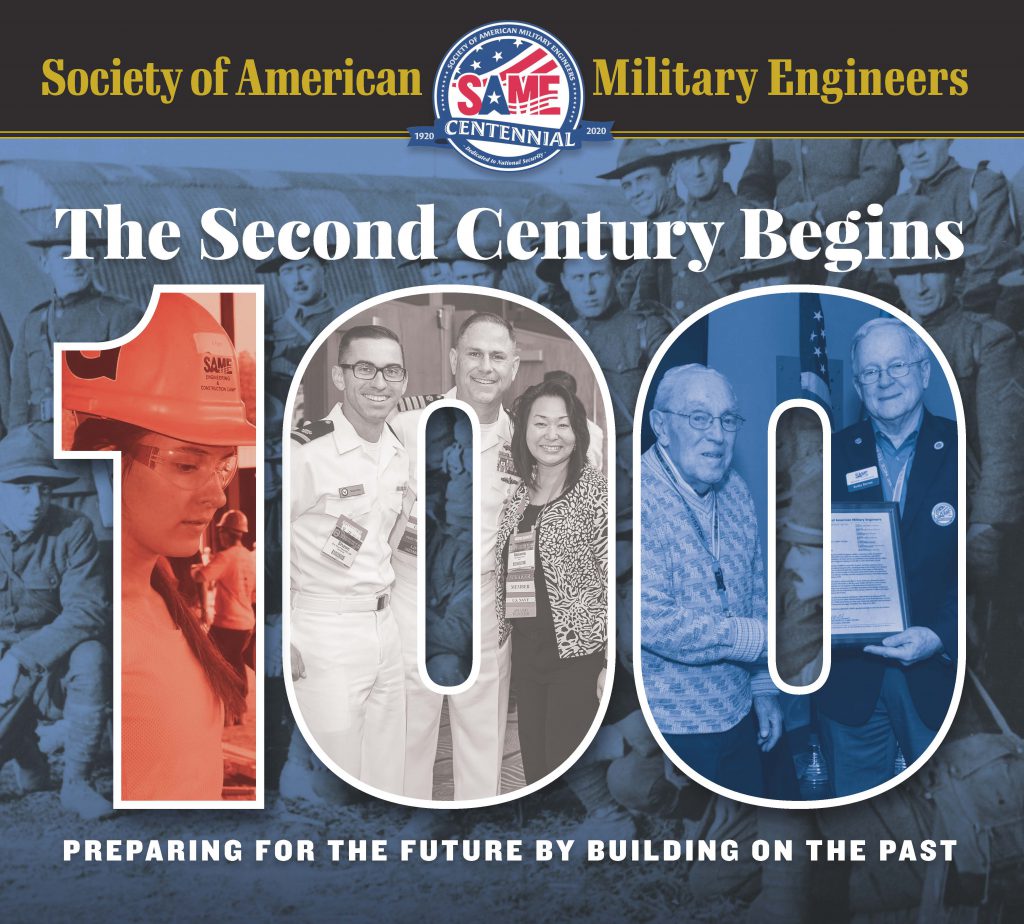

Cindy: I often say to Mark Handley that there’s always a reason for something. I think Heather was exactly the type of President our Society needed during the virtual period and the COVID phase. She managed that so succinctly, and it allowed her to get exposure to many of our Posts. I can be honest and tell you somebody like me who’s very much a people person, and I want to be out there with folks, I probably would have struggled horribly trying to go to a one year virtual environment. But she did a phenomenal job with that, and I think that leadership helped us through and defined how we adapted. I also think that’s what allowed me to reach out to so many Posts, is because that was my strength, that I brought when we were all coming back together.
Buddy: I kidded to Heather one time. I said, I think you got to all 102 Posts during your year. No one’s ever made it to all like you did—and you didn’t have to put one mile on, on an aircraft or a car!
Belle: No one would even imagine how much work time it took to do this. Then, of course, we didn’t know what we were doing. We were learning as we went. We got better.
Joe: It was an all-out, all-hands-on-deck effort is probably the best way to characterize it. Learn what you need to learn, and go do it. Take the initiative to try to solve it. Then step two, don’t hesitate to ask for help. The staff knew that was the ethic. So when you combine all that groundwork, and the mindset and the culture of the office that was in place, it made it easier.
Stephen: Joe always would say during that time period, when you look back at your career years later it won’t be the things you did that you remember most fondly, but the people you did it with.
Mike W.: I came away tremendously impressed with the Society. I am a child of the 1960s and grew up during the Vietnam War protests. Even though my father was a veteran of World War II, and most of the fathers of kids I grew up with were veterans of World War II, and my uncles were Korean War vets, I barely knew anybody in the military. Where I grew up was not heavily military. So it was very interesting, in particular, meeting Joe, who’s my contemporary, he’s about my age and we hit it off tremendously and had a very good time together. It was eye opening to me, that here was this guy who was like other people that I grew up with but had taken such a different route, and had been in the military. Then I met a whole bunch of other members who were military through the Century Book project and they all were salt of the earth. They were just amazing people. It was overall, a really tremendous experience.
Stephen: The Century Book ended up winning an award [AM&P Gold Award for General Purpose Book]. I attended the awards ceremony in DC with Daniel [Wheatley, TME Editor]. Mike couldn’t attend because COVID was making one of its short-term comebacks and he wasn’t able to travel in. But it was rewarding for others to recognize the legacy of SAME and its resilience, which the book fully captured.
In the years that followed, the Society charged ahead into its new century, taking advantage of a “golden age of IGE” as Mark Handley coined it, as the fallout from the pandemic met new national security concerns. Federal work increased dramatically. Project delivery, partnering, and emerging technologies all became amplified at once. The building blocks that SAME put in place in the years before 2020 to elevate the Society’s role as the leader of collaboration within the public sector A/E/C industry, with a stronger governance and volunteer leadership model, were only amplified by the acute response both around and after Virtual JETC and the subsequent increased level of trust among its stakeholders in its ability to do just that. Together this propelled the organization forward with positive, well-earned momentum as its second century took off.
Part V: Trust, Dedication, Value, Partnership
It wasn’t luck that made Virtual JETC 2020 a success story. Earned trust, engaged membership, and a commitment to providing value, even when the road to doing so is uncertain, allowed SAME to pivot and face the challenge head-on.
Joe: JETC 2020 was a critical point that really launched us into the future. The capabilities we gained during that time, we didn’t give them up after. We used those virtual capabilities to enhance our later face-to-face events. But the 2020 JETC was just that pivot point in our culture.
Cindy: We established a lot of things during COVID, like the Leader Development Program, which will be a legacy to carry forward. But we’re always changing, right? We’re always improving.
Our members were very resilient. They were committed to trying to make it work. We have such an authentic group of members that helped carry and sustain the momentum, the energy.
Cindy Lincicome
Kathy: The technology aspect of doing it all virtually, was kind of like, oh my gosh, this is scary. Knowing that there were so many people watching, and you couldn’t see them, you sometimes didn’t even know if your screen went out. Nowadays, we get on Teams calls like it’s nothing.
Caroline: For myself, I didn’t realize how much I missed SAME, until things were taken away, and how influential the Society is in my life and my career.
Cindy: I don’t think any of us ever expected the pandemic to come in and the impact we felt; it caused us to cancel so many long planned in-person gatherings. But I think absolutely that the relationship we built, and it’s always been our purpose to promote industry-government engagement, helped us find ways to support the government’s mission. During that time and afterwards, helping our agency partners be able to connect with industry, we were definitely what I would consider leading and facilitating those opportunities. We became an integrator.
Buddy: In the five years since, and it really happened as we came out of COVID, because of the remoteness of everything and how often we all communicated together, it drove the senior officers to really get involved. The pandemic didn’t cause that. We started it before 2020; but it accelerated it, and you can see it in the Society today.
Joe: We made it happen. And it’s not just the great team that we built there inside the National Office—it’s all the support and help we received, no matter who we asked. The engineering chiefs, our board members, our strategic partners, our Posts, all our presenters and moderators and sponsors.
Belle: Everyone did what they had to do to make it happen.
Heather: It took people.
Mark: Everybody had a role.
Jill: We really tightened our belts. Nobody got raises. There were no bonuses that year. But it was better to have a job than be out on the street. How we operated and adapted played a big role in our ability to continue to operate, and not have to let anybody go. Joe was pretty adamant about that. He did not want to let anybody go.
Stephen: We were so fortunate that our members, our corporate partners, sponsors, everyone stayed connected and supported us as best they could, given the serious challenges that were everywhere. Their continued support and trust in what we were doing was instrumental in the outcome.
Cindy: Our members were very resilient. They were committed to trying to make it work. We have such an authentic group of members that helped carry and sustain the momentum, the energy. We worried, yes: but we stayed resilient.
Joe: Many Posts in the end found ways to do something for their local celebration. The key thought is this: We created a sense of hope with JETC 2020 that carried us through the rest of the pandemic.
Mike D.: Heather Wishart-Smith did a great job as the SAME President pivoting and leading the Society after Virtual JETC. And I can never say enough about the team at the National Office—Ann McLeod, Kathy Off, Belle Febbraro all really stood out, especially with the switch to virtual and the great flexibility they exhibited.
Mark: There’s no substitute for having in person events. We get to look people in the eye and build relationships; but the content that we provide has such value that offering it to folks who are not able to make it through a virtual recording after the fact is tremendous. I think we found that through this period.
Belle: The fact is, with virtual you don’t get to meet the people in person, and that’s what I enjoy most about our conferences. I love to meet our members; it’s like a big family, the SAME family, and it’s great.

Ann: Am I ready to do it again? The whole thing? Oh, my god, no! In hindsight, according to Stephen, it was a good experience. No, I’m kidding. He and I look back on it with a lot of respect and appreciation of what this office was able to do.
Heather: Was it the same thing as having a huge celebration at the convention center in DC? No. And was that disappointing? Yes. But the staff did a phenomenal job and deserves credit for the job that they did.
Joe: I believe the biggest testament to our response to the pandemic, signaled loud and strong by our performance at JETC 2020, is the SAME 2030 Strategic Plan. If you follow the evolution of the Society from 2015 to today, you will see the huge impact that 2020 had on accelerating our move forward.
Buddy: My first pair of red shoes are in the Centennial Time Capsule that Joe built, which we finally sealed at the 2022 JETC in Colorado. I had worn them at the 2019 JETC when we started the Sprint to the Start of our Second Century. They were also kind of enough to put me in one of the zeroes on the Century Book cover, from a visit I had made out to Portland to meet one of our oldest members and original SAME Fellow, Bud Ossey, for his 100th birthday, as part of our Centennial Celebration, fortunately before he passed away. There are people like Bud who have been involved in the Society for years, for decades. I’m glad we were able to recognize him and so many others through the book, and the other events and celebrations that eventually were held.
Joe: I wrote an email to the staff the day we cancelled Capital Week, and I’ll read the last few sentences: “Any time you are feeling a bit overwhelmed, or confused, or even afraid, just talk to one of us … you will never be the only one who needs to talk. This situation is far from the severity of many crises that I’ve dealt with; we will get through this together.” That’s what I said on March 12, 2020, and I said it over and over again. I’ll tell you what: because we had a great team, they responded—and the part that I think you need to celebrate most as you do your research and talk to people, and the one thing that I think needs to come out loud and clear is how every member of that National Office team gave their all.
Ann: It seems so long ago, even though it really wasn’t.
Buddy: It was an interesting time.
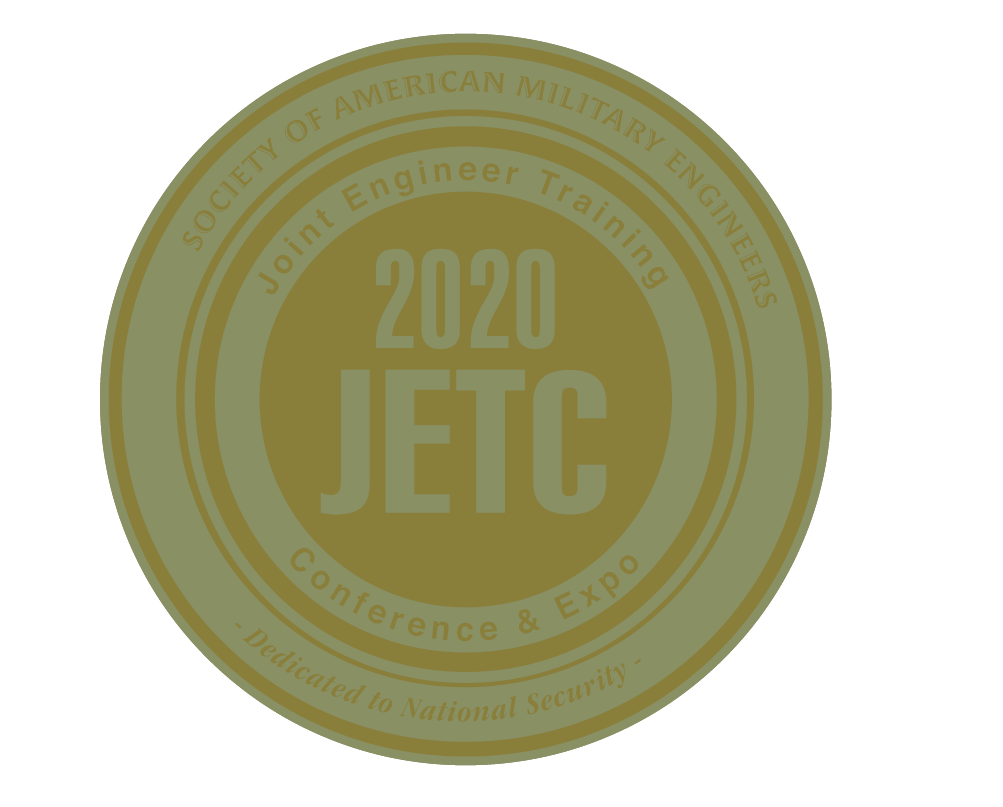
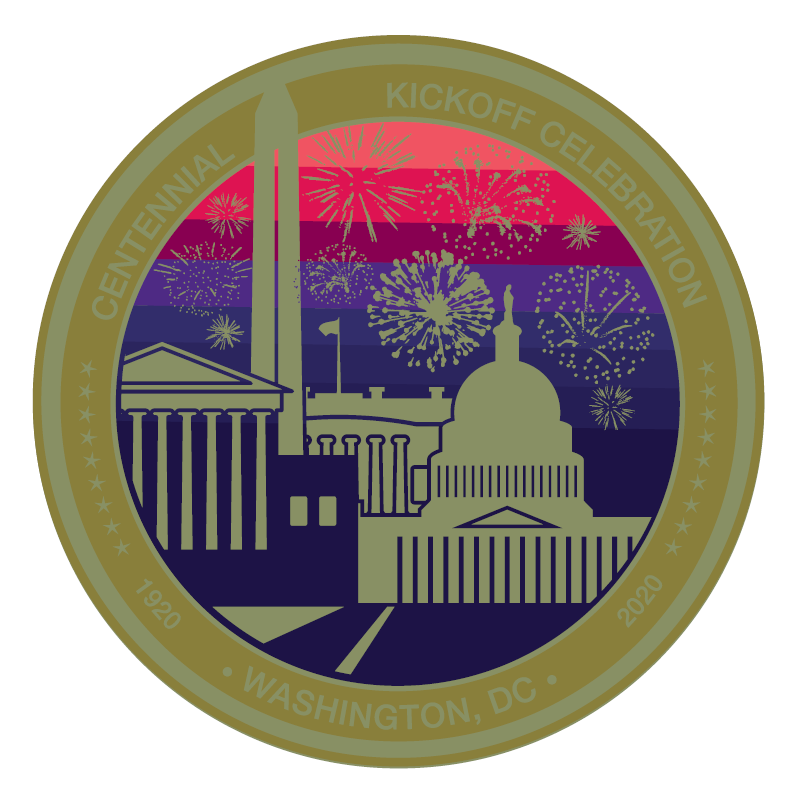
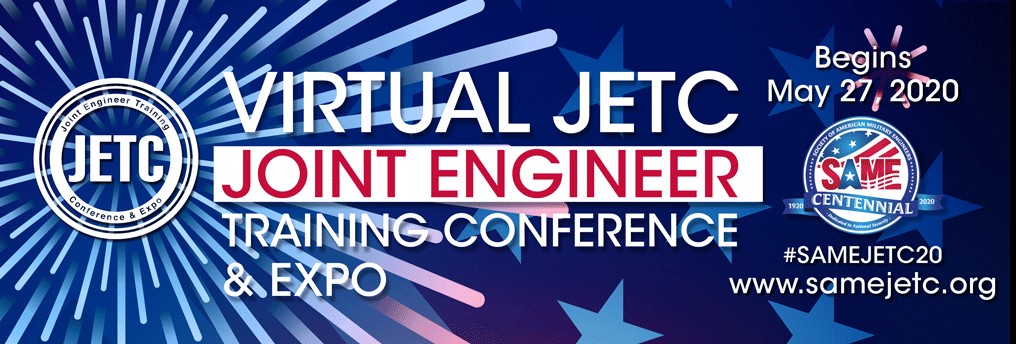
From origins in the midst of a global pandemic in 1920, to celebrating its Centennial in 2020 in the face of another, SAME embraced its circumstances, leaned on staff, leadership, and members, and continued to provide value to the profession and enhance America’s military engineering readiness.
The next 100 years will present its own unforeseen challenges—but what is certain is that the Society will face them with the same fortitude and resiliency it has always shown, “in the interests of patriotism and national security.”
I have been a member of this Society since its inception. Its span of years has seen the most remarkable rate of development of civilization the world has ever witnessed. This accomplishment has synchronized with some of the most acute perils the human race has ever known and overcome. In both categories the engineer has distinguished himself and his profession. Not only in what he has done but in what he has prevented from being done, he has established himself as one of the basic pillars of modern society. I have belonged to many distinguished groups but none in which I have a greater sense of honor than in the Society of American Military Engineers.
General of the Army Douglas MacArthur, SAME Charter Member, Letter to Society Leadership, 1954
Look Back to May 2020
VJETC Daily Recap, May 27 | VJETC Daily Recap, May 28 | VJETC Daily Recap, May 29
Discover More SAME History
SAME Century Book | WWI-Era TME Issue | Society History Webpage
Our sincere appreciation to those Society leaders and National Office staff who participated in this Oral History. Many other members and staff were instrumental in the Run to 2020, the execution of Virtual JETC and subsequent virtual events through 2021, and in the planning, preparing, and execution of countless programs, events, and activities in the years surrounding SAME’s Centennial, locally, regionally, and nationally. The reflections in this Oral History are edited for length and clarity, and were drawn from interviews over several weeks in fall/winter 2024.

